Navigation /
Home /
Index /
Documents /
Photos /
Stories /
Gravestones /
Obits /
Generation 7 /
Generation 9
Boat(w)right Family Genealogy in America
Generation 8
8-125. WILLIAM THOMAS BOATWRIGHT (ANANIAS8, JACOB7, WILLIAM6, THOMAS5, JOHN4, JOHN3, JOHN2, Not Yet Determined1) was born
1819 in Tennessee, and died Aft. 1880 in Dyer County, Tennessee. He married
ISABELLA J. WORTHINGTON. She was born 1821 in North Carolina, and died Aft. 1880 in Dyer
County, Tennessee.
Notes for WILLIAM THOMAS BOATWRIGHT:
1850 Census:
Name: William Boatwright
Date: October 31, 1850
Age: 30
Estimated birth year: abt 1820
Birth place: Tennessee
Gender: Male
Home in 1850
(City,County,State): District 9, Obion, Tennessee
Occupation: Farmer
Page: 374
Roll: M432_891
1860 Census:
Name: W T Boatwright
Date: September 5, 1860
Age in 1860: 41
Birthplace: Tennessee
Home in 1860: District 9, Dyer, Tennessee
Occupation: Farmer
Gender: Male
Value of real estate: $0
Post Office: Dyersburg
Roll: M653_1248
Page: 373
Year: 1860
Head of Household: W T Boatwright
1880 Census:
Name: William T. BOATRIGHT
Date: June 29, 1880
Age: 51
Estimated birth year: <1829>
Birthplace: Tennessee
Occupation: Farming
Relationship to head-of-household: Self
Home in 1880: District 5, Dyer, Tennessee
Marital status: Married
Race: White
Gender: Male
Spouse's name: Isabella BOATRIGHT
Father's birthplace: TN
Mother's birthplace: TN
Census Place: District 5, Dyer, Tennessee;
Roll: T9_1253; Family History Film: 1255253; Page: 133B;
Enumeration District: 15; Image: .
Notes for ISABELLA J. WORTHINGTON:
1850 Census:
Name: Isabella Boatwright
Date: October 31, 1850
Age: 27
Estimated birth year: abt 1823
Birth place: North Carolina
Gender: Female
Home in 1850
(City,County,State): District 9, Obion, Tennessee
Page: 374
Roll: M432_891
1860 Census:
Name: I Boatwright
Date: September 5, 1860
Age in 1860: 38
Birthplace: North Carolina
Home in 1860: District 9, Dyer, Tennessee
Gender: Female
Value of real estate: $0
Post Office: Dyersburg
Roll: M653_1248
Page: 373
Year: 1860
Head of Household: W T Boatwright
1880 Census:
Name: Isabella BOATRIGHT
Date: June 29, 1880
Age: 59
Estimated birth year: <1821>
Birthplace: North Carolina
Occupation: Keeping House
Relationship to head-of-household: Wife
Home in 1880: District 5, Dyer, Tennessee
Marital status: Married
Race: White
Gender: Female
Spouse's name: William T. BOATRIGHT
Father's birthplace: NC
Mother's birthplace: NC
Census Place: District 5, Dyer, Tennessee;
Roll: T9_1253; Family History Film: 1255253; Page: 133B;
Enumeration District: 15; Image: .
Children of WILLIAM BOATWRIGHT and ISABELLA WORTHINGTON are:
9-269. i. MARTHA BOATWRIGHT, b. 1844, Tennessee.
9-270. ii. JOHN W. BOATWRIGHT, b. 1846, Tennessee.
9-271. iii. REBECCA ANN BOATWRIGHT, b. 1848, Tennessee.
9-272. iv. JAMES T. BOATWRIGHT, b. 1851, Tennessee; d. Abt. 1879, Dyer County,
Tennessee.
9-273. v. MARY FRANCES BOATWRIGHT, b. 1851, Tennessee; d. 08 Mar 1922, Dyer
County, Tennessee.
9-274. vi. WILLIAM A. BOATWRIGHT, b. 24 Oct 1857, Dyer County, Tennessee;
d. 30 Jul 1945, Dyersburg, Dyer County,
Tennessee.
9-275. vii. ARTEMSIS E. BOATWRIGHT, b. 1859, Dyer County, Tennessee.
9-276. viii. ANANIAS NORRIS BOATRIGHT, b. 1862, Dyer County, Tennessee;
d. 18 Apr 1935, Hunt County, Texas.
9-277. ix. CHARLES M. BOATWRIGHT, b. 1868, Dyer County, Tennessee.
8-126. MARY BOATWRIGHT (THOMAS8, JACOB7, WILLIAM6, THOMAS5, JOHN4, JOHN3, JOHN2, Not Yet Determined1) was born
1826 in Henderson County, Tennessee. She married JAMES WISE. He was born 1828 in
Tennessee, and died Bef. 1860 in Tennessee.
Notes for MARY BOATWRIGHT:
1850 Census:
Name: Mary Wise
Date: November 29, 1850
Age: 22
Estimated birth year: abt 1828
Birth Place: Tennessee
Gender: Female
Home in 1850 (City,County,State): District 16, Henderson, Tennessee
Census Place: District 16, Henderson, Tennessee;
Roll: M432_883; Page: 224B; Image: 452.
living next door to Mary parents
1860 Census:
Name: M. Wise Boatwright
Date: September 18, 1860
Age in 1860: 34
Birthplace: Tennessee
Home in 1860: District 20, Henderson, Tennessee
Gender: Female
Value of real estate: $0
Post Office: Lexington
Roll: M653_1256
Page: 327
Year: 1860
Head of Household: Tm Boatwright
Notes for JAMES WISE:
1850 Census:
Name: Mary Wise
Date: November 29, 1850
Age: 22
Estimated birth year: abt 1828
Birth Place: Tennessee
Gender: Female
Home in 1850 (City,County,State): District 16, Henderson, Tennessee
Census Place: District 16, Henderson, Tennessee;
Roll: M432_883; Page: 224B; Image: 452.
living next door to Mary parents
8-127. JAMES BOATWRIGHT (THOMAS8, JACOB7, WILLIAM6, THOMAS5, JOHN4, JOHN3, JOHN2, Not Yet Determined1) was born
1831 in Henderson County, Tennessee.
Notes for JAMES BOATWRIGHT:
1850 Census:
Name: James Boatright
Date: November 29, 1850
Age: 19
Estimated birth year: abt 1831
Birth place: Tennessee
Gender: Male
Home in 1850
(City,County,State): District 16, Henderson County, Tennessee
Page: 224
Roll: M432_883
8-128. SAMUEL A. BOATWRIGHT (THOMAS8, JACOB7, WILLIAM6, THOMAS5, JOHN4, JOHN3, JOHN2, Not Yet Determined1) was born
1833 in Henderson County, Tennessee, and died 23 Oct 1864 in Florence, Florence County, South
Carolina. He married NANCY CAROLINE DEROSSETT. She was born 1835 in Tennessee, and died
04 Sep 1871 in Henderson County, Tennessee.
Notes for SAMUEL A. BOATWRIGHT:
Samuel is not listed in the Florence National Cemetery but the high number buried there are
unknown. Samuel was captured on March 24, 1864 at Union City, Tennessee. Samuel was held
at Andersonville Prison in Georgia from April 21, 1864 until early September, 1864. Samuel was
then transferred to Florence, South Carolina prisoner camp, where he died on October 23, 1864.
See notes on Andersonville Prison Camp under Ananias
Boatwright (Samuel's brother).
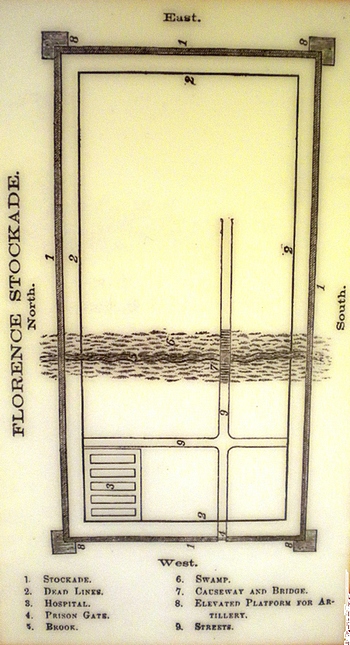 The Florence Prison Stockade was in operation for approximately 5 months during the time
period of Sept 1864 through Feb 1865. During this time, as many as 15 - 18,000 Union
soldiers were held captive. Of these, approximately 2,802 Union soldiers died; most of
whom are buried as unknowns in the Florence National Cemetery.
The Florence Prison Stockade was in operation for approximately 5 months during the time
period of Sept 1864 through Feb 1865. During this time, as many as 15 - 18,000 Union
soldiers were held captive. Of these, approximately 2,802 Union soldiers died; most of
whom are buried as unknowns in the Florence National Cemetery.
The idea of building a stockade at Florence, SC began when General Sherman, after
capturing Atlanta, posed a great threat towards liberating the Union soldiers held
captive at Andersonville and other southern Georgia stockades. It was determined that
the prisoners had to be moved out of the path of Sherman's advancing troops. Florence was
chosen by Confederate authorities for the site of a new stockade due to the fact that
there were three railroads that centered in the town, which would ease the operation of
transporting and receiving prisoners.
Major General Samuel Jones ordered Major Frederick F. Warley, who had been recently
exchanged from a Northern prison camp, to construct a stockade in Florence. Work began
with approximately 1,000 slaves being assigned to the project from the local area.
At Andersonville in late August and early September 1864, thousands of Union prisoners
were told by Captain Wirz that they would all be paroled, except for those who could not
walk and were unable to travel. The talk of parole was merely a way to keep the prisoners
under control and a way of trying to prevent escape during their relocation. The prisoners
being relocated were divided into three groups. One group was sent to Savannah, GA,
another to Charleston, SC and the last group went directly to Florence, SC. Left behind
at Andersonville were those who could not walk and who would be no threat if liberated.
Many of these died off rapidly.
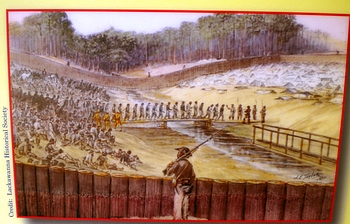 Most of the prisoners that were sent to Savannah would eventually find themselves back at
Andersonville after being held captive in various prisons in Georgia. Although, some of
these did end up at Florence. Those that arrived in Charleston were mainly held at the
Charleston Race Course, which today is known as Hampton Park. Some were also held in the
jailyard of the Charleston City Jail and the Workhouse. All of these were holding areas
for the prisoners until the building of the stockade at Florence could be completed.
Most, if not all, of the Enlisted prisoners at Charleston were sent to Florence.
Most of the prisoners that were sent to Savannah would eventually find themselves back at
Andersonville after being held captive in various prisons in Georgia. Although, some of
these did end up at Florence. Those that arrived in Charleston were mainly held at the
Charleston Race Course, which today is known as Hampton Park. Some were also held in the
jailyard of the Charleston City Jail and the Workhouse. All of these were holding areas
for the prisoners until the building of the stockade at Florence could be completed.
Most, if not all, of the Enlisted prisoners at Charleston were sent to Florence.
During the construction of the stockade, there was a rapidly deteriorating situation in
Charleston due to the spread of such diseases as Small Pox & Yellow Fever. Due to this
situation, 5 to 6,000 of the prisoners were sent to Florence before the completion of
the stockade, arriving in Florence on the 14th of September. Since the stockade was far
from complete when the prisoners began to arrive, they were gathered into a field close
to the train tracks. Being assembled in an open field made the possibility of escape a
reality and was of great concern to Major Warley, not to mention the fact that the
prisoners were "in a state of mutiny" and could cause major problems in the surrounding
area; including the possible destruction of the railroads. Warley requested assistance
from Major General Roswell S. Ripley, the commander at Charleston, to help with the
situation. Due to the imminent danger involved, Warley couldn't wait and sent out trains
to the surrounding community to gather every available man to assist in the completion
of the stockade. The prisoners were finally moved into the stockade on the first Sunday
of October 1864.
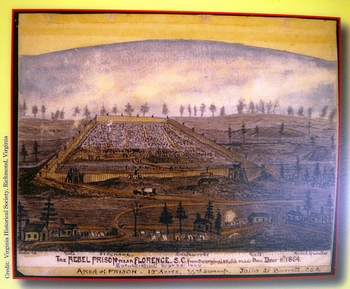
The design of the stockade was much like that of Andersonville. Upright un-hewn timbers
were sunk about 5 feet into the ground encasing about 23 1/2 acres; six of which were
swamp. The walls of the stockade were roughly 1,400 by 725 feet and approximately 12 - 16
feet tall. Like Andersonville, a stream (Pie Branch) ran through the center of the
stockade. This stream was slightly larger than the one at Andersonville, but still proved
to be inadequate.
One major difference in the design changes between Andersonville and Florence is that a
deep trench was dug around the Florence Stockade to eliminate prisoners from trying to
tunnel out. The soil from the trench was then pushed up against the outer walls of the
stockade, which provided a platform for the guards to man their posts and also added
stability to the log walls. Some accounts also state that there was an inner trench or
furrow, as well as a row of boards, used for the deadline.
An additional difference, in comparing Andersonville to Florence, was that the trees
previously within the boundaries of the walls had recently been cut, leaving many stumps
behind, which were used as firewood. There were also several smaller trees left inside,
which were put to the same use. Also, wood was supplied to the stockade, although in
small amounts. This wood was gathered during the winter months by a prisoner wood
squad.
Major Warley had been wounded prior to his imprisonment and the building of the Florence
Stockade. His wounds began to bother him and he requested to be relieved of his duties
at the stockade, being replaced by Colonel George P. Harrison, Jr. of the 32nd GA by the
20th of September, with Lt. James Barrett of the 5th GA in command of the interior of the
stockade. Harrison became known for his fair treatment of prisoners. While, on the other
hand, Barrett was known for being the most brutal. Many accounts state that Lt. Barrett
was far more brutal than Capt. Wirz.
By October 12th of 1864 there were 12,362 prisoners at the stockade, with a death rate of
between 20 & 30 per day. At this time, three-fourths of the prisoners were without
blankets, and quite a few were close to being naked. Luckily, a supply of goods and
clothes were delivered to the stockade from the Sanitary Commission about the middle of
October.
Around the first of November, another supply of clothes arrived at the stockade from the
Sanitary Commission. These items were dispersed to the prisoners who were in most need
of them. Also, around this time, the northwest corner of the stockade was separated from
the main part for the construction of a hospital, which consisted of rude barracks.
The prisoners totaled 11,424 for November, and towards the end of the month, orders came
to make out parole rolls for the most severely sick and wounded prisoners. Any prisoner
wishing to be paroled had to undergo an inspection to determine if his case was severe
enough to be paroled.
On December 6, 1864, public criticism led to the appointment of Lieutenant Colonel John
F. Iverson as the commander of the stockade. During the first half of December the
prisoners who were selected for parole were sent by rail to Charleston where they would
stay for a few days before boarding the flag-of-truce boats. After their parole, they
were shipped to Camp Parole, Annapolis, Maryland. Due to these paroles the number of
prisoners had decreased to 7,538 with the death rate decreasing to 6 per day for January
1865.
Brigadier General John H. Winder, commander of all of the Southern prisons east of the
Mississippi, was at Florence when he died of a heart attack in front of the Sutler Tent
on February 6th, 1865. Due to an inadequate water supply and its close proximity to
Federal cavalry, Winder had been trying to close the stockade at Florence. After Winder's
death, Colonel Henry Forno made preparations to have the prisoners relocated. Sherman
had cut the last railroad link to southwest Georgia, so it was decided to have the
prisoners relocated to North Carolina. After much discussion about what to do with the
prisoners, all able-bodied prisoners were sent to Greensboro, where they would be
paroled and sent to Camp Parole, Annapolis, MD. Most of the sick and wounded prisoners
were sent to N. E. Ferry at Wilmington to be paroled as well. By the end of February
1865, the stockade was empty.
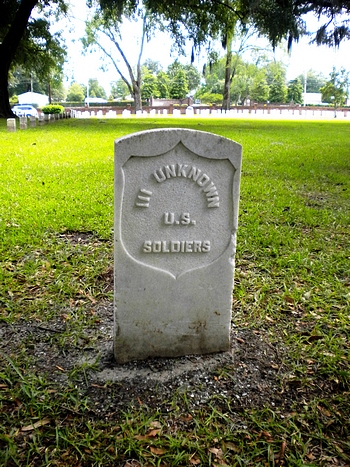 Capt. Wirz was later hung for war crimes related to Andersonville, but Lt. Barrett
escaped this same fate by fleeing to Germany where he married and remained many years.
He would die later of natural causes in 1910 at Augusta, Georgia.
Capt. Wirz was later hung for war crimes related to Andersonville, but Lt. Barrett
escaped this same fate by fleeing to Germany where he married and remained many years.
He would die later of natural causes in 1910 at Augusta, Georgia.
The Florence Stockade has not received the same notoriety as Andersonville, but the
conditions were very much the same. In fact, by many accounts, Florence was worse. It
must also be realized that most of the prisoners at Florence had already survived a hard
summer at Andersonville and now faced going through the winter with little to no clothing
or shelter.
Florence National Cemetery is the smaller of two such shrines in South Carolina; the
other is at Beaufort. Located 1/4 mile north of the former site of the Florence
Confederate Stockade, the cemetery was created when a plantation owner named James H.
Jarrott allowed the dead to be buried in trenches on his property near the camp. The
first burial took place on September 17, 1864, and the cemetery was established as a
National Cemetery in 1865.
Original interments were made in two separate burial grounds, the largest one containing
approximately 2,322 remains. Interments in the larger burial grounds were made in 16
trenches and when the cemeteries were placed under jurisdiction of the federal
government, the larger burial ground was designated a National Cemetery. The remains from
the small burial ground [416 graves] were reinterred at the National Cemetery, as well as
remains moved from Darlington, Cheraw, the Marion Districts and the Magnolia Cemetery in
Charleston.
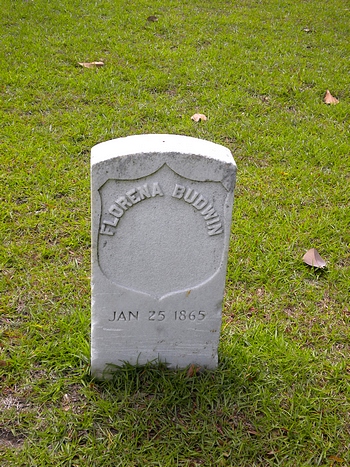 One of the five "known" interments in the trenches is that of Florena Budwin who disguised
herself as a man and enlisted in the Union Army in order to follow her husband, a Captain
from Pennsylvania. Her husband was killed and Florena was captured. Her identity was
finally discovered in the prison stockade at Florence, where she remained to help nurse
the prisoners until she became ill and died on January 25, 1865. She is believed to be
the first female service member to be buried in a National Cemetery. (She has the only
marked grave in Row # 13)
One of the five "known" interments in the trenches is that of Florena Budwin who disguised
herself as a man and enlisted in the Union Army in order to follow her husband, a Captain
from Pennsylvania. Her husband was killed and Florena was captured. Her identity was
finally discovered in the prison stockade at Florence, where she remained to help nurse
the prisoners until she became ill and died on January 25, 1865. She is believed to be
the first female service member to be buried in a National Cemetery. (She has the only
marked grave in Row # 13)
The marker reads:
"On each side of this marker lie the remains of approximately 2300 Union soldiers who
died as prisoners in the Florence Prison Stockade, between September 1864 and February
1865. The Stockade was located across Cemetery Street on Stockade Road. Burials are in
trenches indicated by stone markers at the end of each row, showing the number of
individuals placed there."
Names of those in trench burials were lost after the war but are being researched by the
Old Darlington District Chapter, SC Genealogical Society. A current list of known
casualties is located on a database in the visitor center for public reference. Signs on
Stockade Road indicate the site of the Confederate Stockade. This marker erected by
Friends of the Florence Stockade, May 30, 1998.
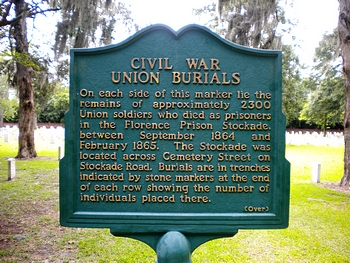 1850 Census:
Name: Samuel Boatright
Date: November 29, 1850
Age: 17
Estimated birth year: abt 1833
Birth place: Tennessee
Gender: Male
Home in 1850
(City,County,State): District 16,
Henderson County, Tennessee
Page: 224
Roll: M432_883
1860 Census:
Name: S Boatwright
Date: September 18, 1860
Age in 1860: 27
Birthplace: Tennessee
Home in 1860: District 20, Henderson, Tennessee
Occupation: Farmer
Gender: Male
Value of real estate: $0
Post Office: Lexington
Roll: M653_1256
Page: 327
Year: 1860
Head of Household: S Boatwright
Civil War Service Records
Name: Samuel Boatwright
Company: A
Unit: 7 Tennessee Cavalry.
Rank - Induction: Private
Rank - Discharge: Farrier
Allegiance: Union
Served with brother Ananias
Code No:69574
Grave No: 0
Last Name: Boatright
First Name: Samuel
Rank: Private
Company: A
Regiment: 7
State: TN
Branch Of Service : Cavalry
Date of Death: 10/23/1864
Remarks* Died in prison at Florence, South Carolina, October 23, 1864
Reference: TN ADG RPT: 478
Place Captured: TN ADG RPT: 478
Date Captured: 3/24/1864
1850 Census:
Name: Samuel Boatright
Date: November 29, 1850
Age: 17
Estimated birth year: abt 1833
Birth place: Tennessee
Gender: Male
Home in 1850
(City,County,State): District 16,
Henderson County, Tennessee
Page: 224
Roll: M432_883
1860 Census:
Name: S Boatwright
Date: September 18, 1860
Age in 1860: 27
Birthplace: Tennessee
Home in 1860: District 20, Henderson, Tennessee
Occupation: Farmer
Gender: Male
Value of real estate: $0
Post Office: Lexington
Roll: M653_1256
Page: 327
Year: 1860
Head of Household: S Boatwright
Civil War Service Records
Name: Samuel Boatwright
Company: A
Unit: 7 Tennessee Cavalry.
Rank - Induction: Private
Rank - Discharge: Farrier
Allegiance: Union
Served with brother Ananias
Code No:69574
Grave No: 0
Last Name: Boatright
First Name: Samuel
Rank: Private
Company: A
Regiment: 7
State: TN
Branch Of Service : Cavalry
Date of Death: 10/23/1864
Remarks* Died in prison at Florence, South Carolina, October 23, 1864
Reference: TN ADG RPT: 478
Place Captured: TN ADG RPT: 478
Date Captured: 3/24/1864
Burial: Florence National Cemetery, Florence, Florence County, South Carolina
Notes for NANCY CAROLINE DEROSSETT:
1860 Census:
Name: N C Boatwright
Date: September 18, 1860
Age in 1860: 25
Birthplace: Tennessee
Home in 1860: District 20, Henderson, Tennessee
Gender: Female
Value of real estate: $0
Post Office: Lexington
Roll: M653_1256
Page: 327
Year: 1860
Head of Household: S Boatwright
Burial: Oak Grove Cemetery, Henderson County, Tennessee
Children of SAMUEL BOATWRIGHT and NANCY DEROSSETT are:
9-278. i. M. A. BOATWRIGHT, b. 1855, Henderson County, Tennessee.
9-279. ii. L. J. BOATWRIGHT, b. 1857, Henderson County, Tennessee.
9-280. iii. JAMES THOMAS BOATRIGHT, b. 24 Jan 1859, Lexington, Henderson County,
Tennessee; d. 12 Dec 1935, Portageville,
New Madrid, Missouri.
8-129. ANANIAS NORRIS BOATWRIGHT (THOMAS8, JACOB7, WILLIAM6, THOMAS5, JOHN4, JOHN3, JOHN2, Not Yet Determined1) was born
1835 in Henderson County, Tennessee, and died 27 Jun 1864 in Andersonville, Sumter County,
Georgia. He married SARAH A. GARNER Abt. 1860 in Henderson County, Tennessee, daughter
of CULLEN GARNER and RACHEL. She was born 1846 in Tennessee.
Notes for ANANIAS NORRIS BOATWRIGHT:
Ananias served in the 7th Tennessee Cavalry (Union). Ananias died at Andersonville Prison
Camp, Andersonville, Georgia on June 27, 1864, two months after arriving at the camp.
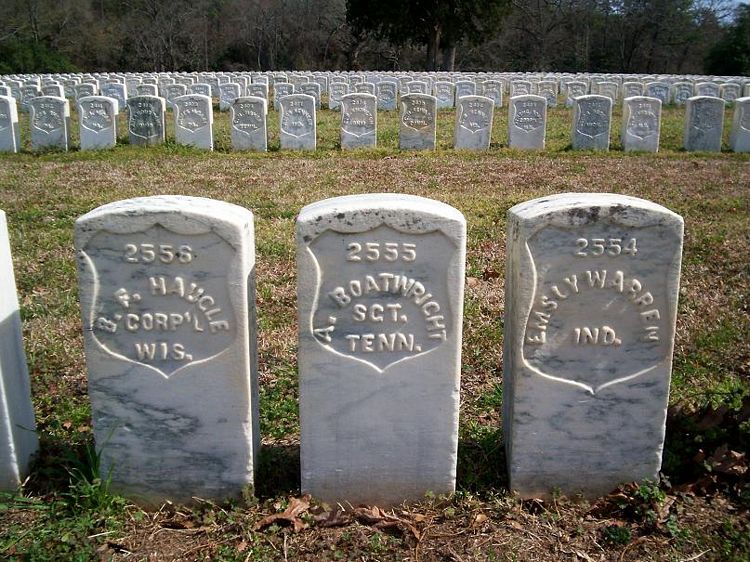
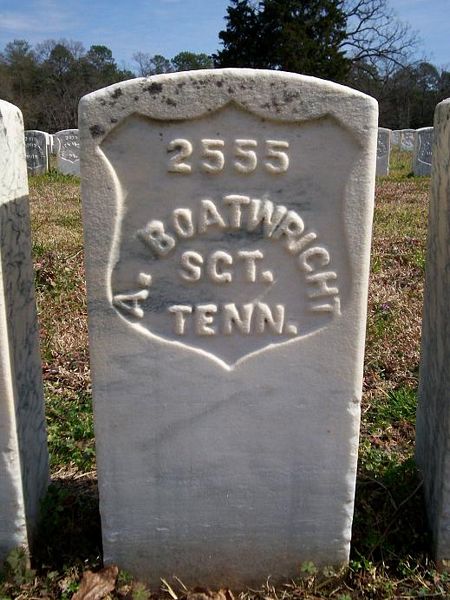
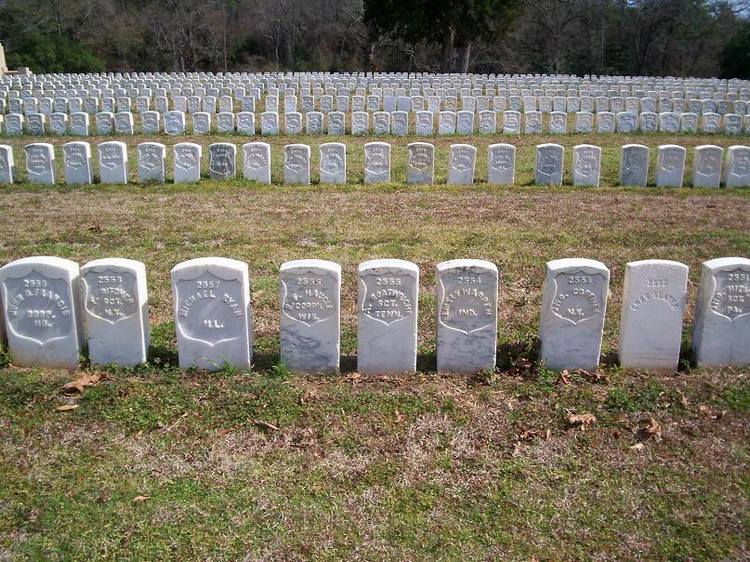
Grave No: 2555
Last Name: Boatwright
First Name: Ananias
Rank: Sergeant
Company: A
Regiment: 7
State: Tennessee
Branch Of Service : Cavalry
Date of Death: 6/27/1864
Cause of Death: Diarrhea
Place Captured: Union City, Tennessee
Date Captured: 3/24/1864
Status: Died at Andersonville
Andersonville, or Camp Sumter as it was officially known, was one of the largest of many established prison
camps during the American Civil War. It was built early in 1864 after Confederate officials decided to move
the large number of Federal prisoners kept in and around Richmond, Virginia, to a place of greater security
and a more abundant food supply.
The pen initially covered about 16 1/2 acres of land enclosed by a 15 foot high stockade of hewn pine logs. It
was enlarged to 26 1/2 acres in June of 1864. The stockade was in the shape of a parallelogram 1,620 feet
long and 779 feet wide. Sentry boxes, or "pigeon roost" as the prisoners called them, stood at 30 yard
intervals along the top of the stockade. Inside, about 19 feet from the wall, was the " DEADLINE ," which the
prisoners were forbidden to cross upon threat of death. Flowing through the prison yard was a stream called
Stockade Branch, which supplied water to most of the prison.
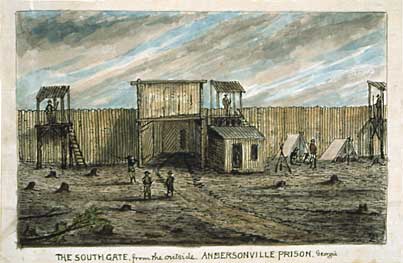
Two entrances, the North Gate and the South Gate, were on the West side of the stockade.
Eight small earthen forts located around the exterior of the prison were equipped with
artillery to quell disturbances within the compound and to defend against feared Union
cavalry attacks. The first prisoners were brought to Andersonville in February, 1864. During the next few
months approximately 400 more arrived each day until, by the end of June, some 26,000 men were confined
in a prison area originally intended to hold 13,000. (Source: Kevin Frye: Frye@pstel.net)
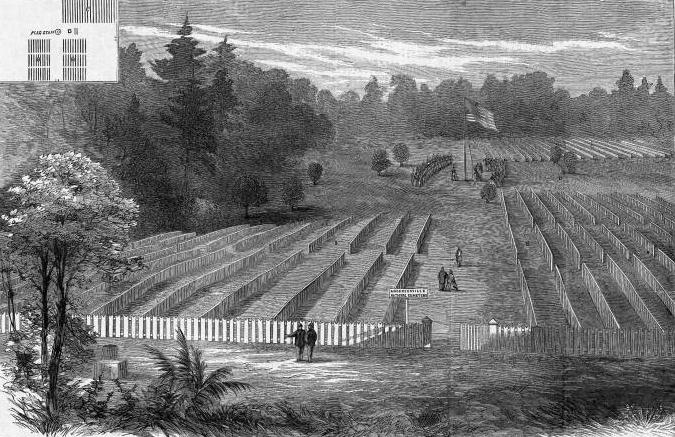
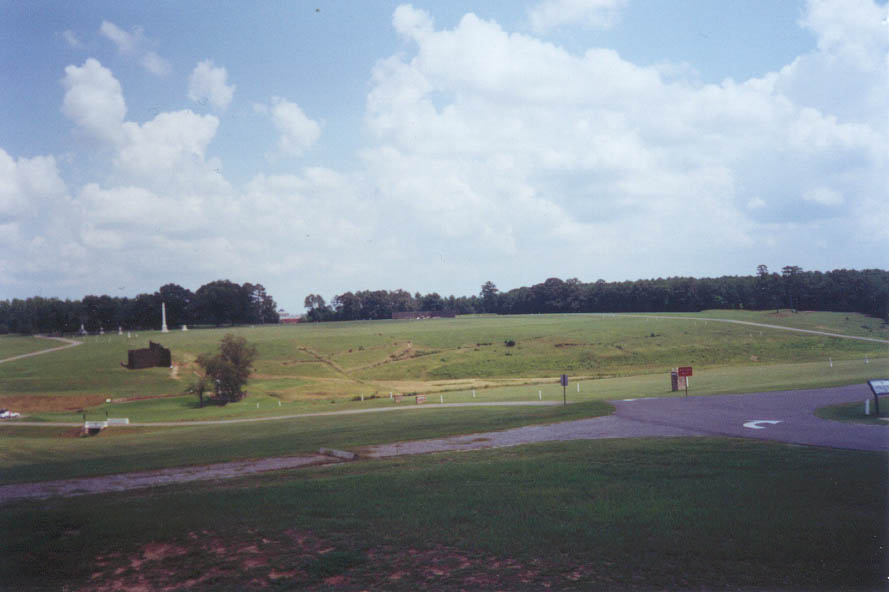
THE SEVENTH TENNESSEE VOLUNTEER CAVALRY
WEST TENNESSEE UNIONISTS IN ANDERSONVILLE PRISON
BY PEGGY SCOTT HOLLEY
The Confederacy established Andersonville, that most infamous of Civil War prisons, in late February, 1864.
It built a stockade in west central Georgia to accommodate approximately 10,000 prisoners of war. As the
fighting moved ever deeper into the South in the last year of the war, the expanded stockade at one point held
nearly 33,000 Union soldiers. The termination by the North of the prisoner of war exchanges which had
existed previously and the continually depleting resources of the Confederacy left these prisoners stranded in
miserable conditions.
By the end of the war, 13,000 of the total 45,000 prisoners had died. They were buried in shallow trench
graves with numbers to identify the dead. The northern states erected large memorial monuments of the site
of the prison after the war to honor their citizens who died there. Tennessee also built a monument to
commemorate the more than 750 men from Tennessee who died there. The suffering of these men was
recognized even though they did not support the decision of the state to join the Confederacy.
About half of the Tennesseans in Andersonville were from East Tennessee. The mountain area of eastern
Tennessee had been unsympathetic to the southern case. Mountain people were often unwilling to fight to
preserve a plantation economy in which they did not participate. Furthermore, many were also stauchly
Unionist. Several Union regiments had been raised in the east including the 2nd Tennessee Infantry, which
had 475 of its men captured at Rogersville, Tennessee and sent to Andersonville Prison.
The West Tennessee Unionists in Andersonville, however, were not mountaineers but were farmers from a
cotton growing area of small farms and plantations. The largest number of West Tennesseans, about 450,
were from the 7th Tennessee Volunteer Cavalry (including both Ananias and brother Samuel) The entire
regiment, except for one group on scout was
captured at Union City, Tennessee on March 24, 1864 by a detachment of Gen. Nathan Bedford Forrest's
regiment under the command of Col. William L. Duckworth. The captured men were mainly from Carroll,
Henderson and McNairy Counties with some recruits from Henry, Weakley, Benton, Madison, Gibson,
Hardin, and Decatur counties. These men suffered horribly during the time they were prisoners. Two-thirds
of them died within a year of the capture. Their high mortality rate can be attibuted both to the prison to
which they were sent and to the actions of their captors.
One group within the captors of the 7th Tennessee Cavalry USA was the 7th Tennessee Cavalry CSA. Both
groups were primarily West Tennesseans and there was intense ill feeling between them. Some men were
neighbors and personally knew each other. For the 7th Tennessee USA, the humiliation was almost total.
Colonel Duckworth tricked them into surrender when help was nearby. And, it was the second time that
Forrest's men had forced them to surrender. The first time at Trenton in December, 1862, they had been
paroled and had spent their time at Camp Chase, Ohio. Some members of the regiment, who were captured at
Ripley and Mt. Pinson, Tennesse, had even spent a short time in Richmond, Virginia in 1863 before being
parolled once again. By March 1864, however, the Lincoln government had stopped the exchanges. This
time there would be no paroles. The men were prisoners of the Confederacy and were destined for
Andersonville Prison.
The captors "had a lot of fun" at the expense of their prisoners because of the circumstances of the surrender.
They taunted the "Tennessee Yanks" for giving up without a fight. John Milton Hubbard, who was one of the
privates among Forrest's men that day, later wrote that the men of the Seventh Tennessee USA "bore up
manfully and turned out to be jolly good fellows, molded much after the pattern of the men of our own
Seventh Tennessee Confederate." He even called Lt. Colonel Isaac R. Hawkins, a Huntingdon lawyer in
command of the regiment,"that most gentlemanly Federal officer."
After sacking and burning the fort and destroying all the regiment's books and papers, the Confederates
hurriedly left Union City with their prisoners. The Union enlisted men walked four abreast with the
Confederate guard in a single file on each side. Under a light rain, the men marched about sixteen miles to
Gardners's Station, where they camped for the night. Two officers, including Colonel Hawkins' son, escaped
during the night. Later during the trip south, five more Union Officers escaped. At least some of the officers
violated their parole of honor by doing so. This made General Forrest so furious that he made Colonel
Hawkins and the other officers walk for a time in ankle deep mud.
Leaving Gardner's Station at daybreak, the men marched to Trenton, arriving there on the 26th of March.
Their captors gave them almost nothing to eat during the trip but they were able to buy biscuits for five dollars
per dozen and baked chickens for five dollars each from the people of Trenton. It was fortunate they could
spend some of their money. On the next day the Confederate soldiers took them into the courthouse and
robbed them. Since the men had recently been paid their back pay, the captors were able to take a sizeable
amount of money from them as well as other personal articles. Even Colonel Hawkins lost his saddle bags,
extra clothes, and blanket around this time.
Colonel Hawkins protested the robberies to Colonel Duckwork. Duckworth said that Forrest's men were
responsible and that he would put his own men on guard to stop them. When the thefts continued, Hawkins
again protested to Duckworth and was told that an account was being taken of the money involved and that it
would be returned. Both sides sometimes confiscated money from prisoners in order to prevent bribery. The
money would then be given back to its owner in small amounts at the prison or in a lump sum when the
prisoner was exchanged. In this case, however, the money was taken unofficiallly by the enlisted men and
was never returned. In the terms of the capitulation signed by both Hawkins and Duckworth at Union City, it
had been agreed that all private property belonging to the men would be respected. Only their horses, horse
equipment, and arms were to be taken from them. This breach of the surrender terms by Forrest's men later
caused much misery and even death for many of Hawkins's men.
On the 28th of March the group arrived at Humboldt. A citizen there, seeing Colonel Hawkins' predicament,
took pity on him and gave him two pairs of socks and a handkerchief. Their next stop was Jackson, where
they joined Forrest's main force. Here James McCree, a citizen Unionist, sent a dispatch to the Federal
command on the Tennessee River suggesting that Forrest, and his prisoners might be intercepted on their way
south after leaving Jackson. Forrest suspected McCree, arrested him, and would have hanged him except for
the intervention of certain Jackson citizens, who felt McCree might be innocent. After a few days at Jackson,
the prisoners were moved on to near Purdy. The captives hoped that there might be a rescue attempt by
Union troops before the group crossed the Tennessee line. General Forrest, anticipationg trouble, gave orders
that if an attempt was made, the prisoners were to be shot. No help materialized, however. After crossing the
Tennessee line south of Pocahontas, the men entered into northern Mississippi at Ripley, and later were sent
on to Ellistown and Tupelo.
About a month after the prisoners had gone through Tupelo, another group of Union sympathizers from the
same area of West Tennessee as the prisoners were marched through the town. They were private citizens
who had been rounded up in Huntingdon and were being escorted to prison. John A. Crutchfield, a lieutenant
in the 20th Tennessee Cavalry CSA, wrote about them in a letter to his wife in Macedonia, Carroll Co:
"I saw some of our Huntingdon Union Friends footeling it the other Day towards Dici. One certain old man
John Britt and several other I new, Citizens they all were. I was sorry for them, it looked evil to march men
off from their Homes in that way even if they was Union. Old Johnny Britt looked pitiful."
John Britt was a Huntingdon merchant who had three sons in the 7th Tennessee Cavalry USA. At least one of
these sons was with the Union City prisoners. Crutchfield's letter also mentioned that he had heard that Isaac
Hawkins' men were safe at Mobile, Alabama. This was indeed where they had been taken.
Presumably the men walked until they intersected the Mobile and Ohio Railroad somewhere near Tupelo,
Mississippi. On the way to Mobile, two men died of Pneumonia and a rebel guard accidentally shot one
prisoner in the abdomen at Okalona, Mississippi. When they reach Mobile they were placed in a warehouse.
Private Isaac Davenport, from Scotts' Hill in Henderson County, later described the place as "a cotton shed
where the fleas and body lice sucked some of the very life blood out" of them and where they were much too
"numbered" for the space. Ten men died in Mobile. Davenport had to leave his dying brother-in-law, Sam
McCollum, when orders came to ship out.
The prisoners left Mobile by steamer about April 17 for Tensaw, Alabama. Leaving Tensaw on the 18th, they
left by rail on the Mobile and Great Northern Railroad for Pollard. Camping there for the night, they would
then have needed to change to the Alabama and Florida Railroad(Alabama) to ride to Montgomery, where
they arrived on the 19th. Leaving Mongomery the next morning, they crossed into Georgia at Columbus,
where they once again changed trains. Traveling all night on the South Western Railroad, the men arrived at
Andersonville Prison at 8 a.m. on the 21st of April, 1864. The trip from Union City had required just under a
month.
Colonel Hawkins and about ten commissioned officers were separated from the privates and noncommissioned
officers at this time and put on a train for Macon, Georgia. Their arrival at the prison in Macon
brought the number of officers there to a total of fifty. All of the commissioned officers of the 7th Tennessee
Cavalry survived their imprisonment except for Captain M. Wesley Derryberry of Co. H. Two lieutenants,
William W. Murray of Co. I and John J Wallace of Co. K, even managed to escape and both safely reached
Union lines. Colonel Hawkins remained in southern prisons for only five months before being exchanged.
The enlisted men who survived Andersonville averaged eight to thirteen months before their releases.
Camp Sumter, the official name for Andersonville, had opened a little over two months before the 7th
Tennessee arrived. At the time of their arrival the stockade held about 15,000 prisoners or about 50 percent
more than it had been designed to hold. Private Isaac Davenport described his first impression. He thought it
a "despert looking place" and "very gloomy." Robert Kellogg, a Connecticut soldier speaking for some 2000
soldiers who arrived about twelve days later, said that the sight froze their blood with horror, and made their
hearts fail within them. Sergeant Henry M. Davidson of the 1st Ohio Light Artillery, who was an inmate at the
prison, remembered the arrival of Hawkins' Regiment and wrote the following in his memoirs:
"Some five hundred Tennesseans, who had been captured by Forrest---arrived among us; the most of who
were hatless, bootless, and shoeless, without coats, pants and blankets...They were wholly destitute of cups,
plates, spoons, and dishes of every kind as well as of all means of purchasing them; they having been stripped
of these things by their captors. In their destitute condition they were turned into the stockage and left to shift
for themselves in the best manner they could. To borrow cups of the fellow-prisoners was in impossibility,
for no one could be expected to lend what, if it were not returned, would insure his own destruction,
particularly when the borrower was an utter stranger; there was nothing left for them but to bake their raw
meal and bacon upon stones and chips, eat it without moisture, and afterward to go to the brook like beasts to
quench their thirst."
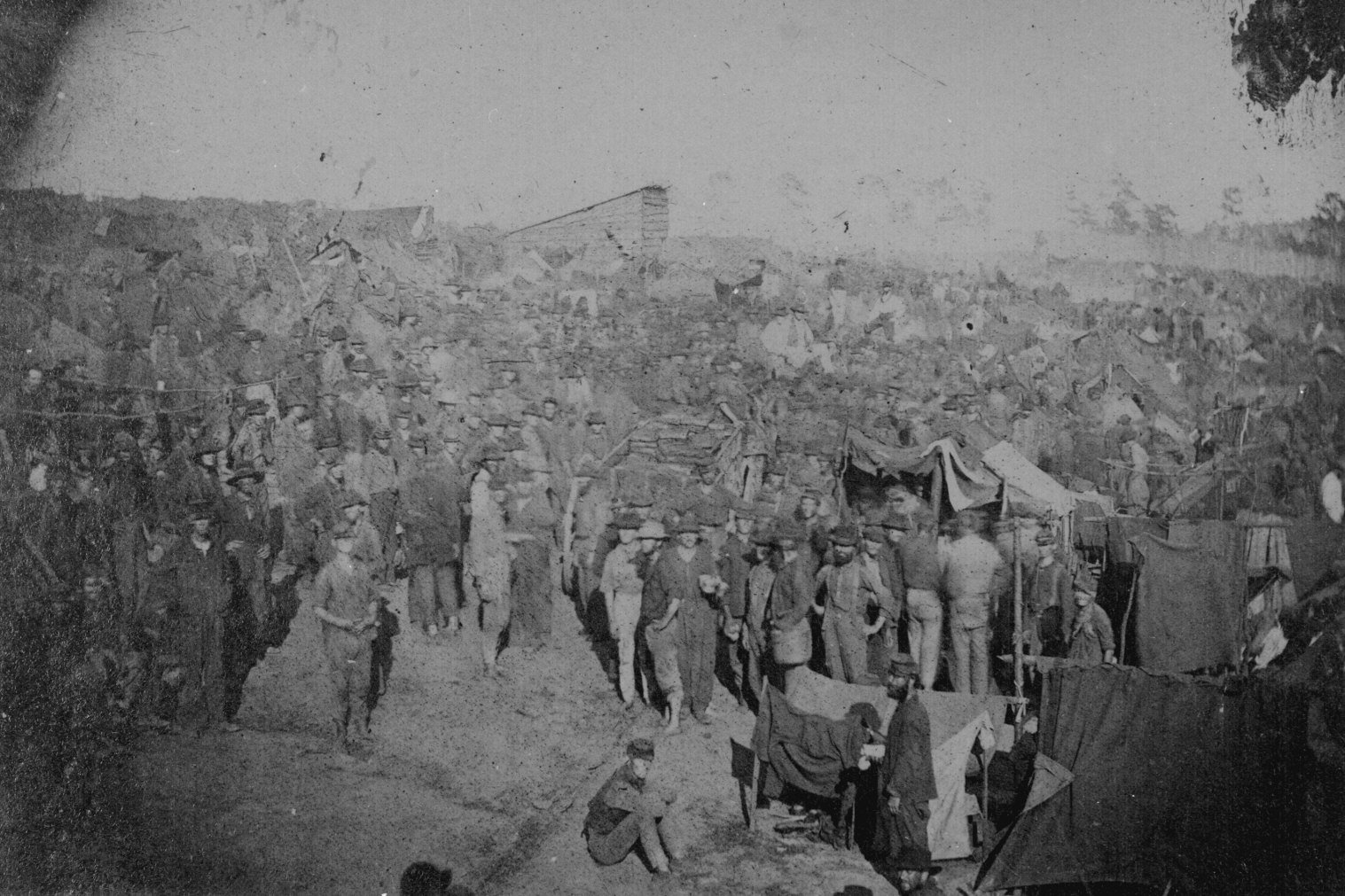
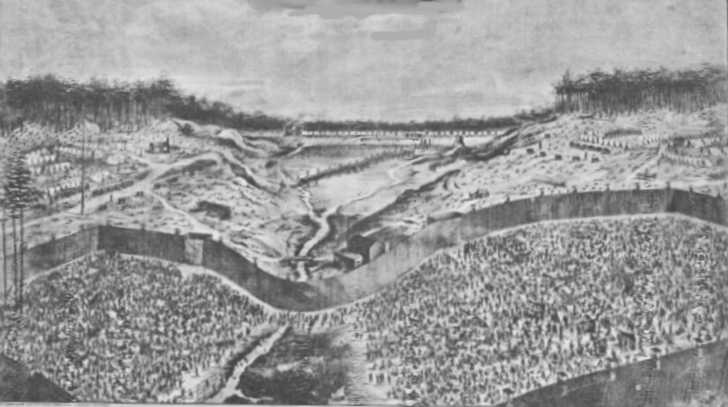
The men also lived with little protection from the elements since no tents were issued. Sergeant Davidson
said that the 7th Tennessee "scooped out shallow places in the earth with their hands, and lying down side by
side in these, with their bare heads and naked feet resting upon the surface of the ground, and their
unprotected bodies wet with dews and storms, the wretched men trembled and shivered till morning.
Members of the regiment later confirmed this in their answers to a Civil War questionnaire. Private William
Douglas wrote that they "slept on the ground, nothing under us or over...we didn't have any cloth." Private
William T. Woods said "we suffered greatly from exposure." Private Isaac Davenport said in his memoir that
their "beds was only the sandy hills...we slept exposed"
Even allowing for a certain amount of exaggeration, the men of the 7th Tennessee arrived at a distinct
disadvantage since they had no money to bargain with their fellow prisoners or with the Confederate guards or
to buy from the prison sutler. Also, as noted above, their blankets, cooking utensils, and clothing either had
been taken from them by their captors or had been thrown away because of the burden of the long forced
marches. They did not even have enough cloth to make crude tents to protect themselves from the elements.
However, some Confederate soldiers respected the private property of their captives. For example, the Union
regiments captured at Plymouth, North Carolina retained their money and their private property. Robert
Kellogg, a member of the Plymouth captives, said that they were allowed to retain their blankets, overcoats,
and all they had with them except their arms and equipment. He reported only one robbery, and that by an
intoxicated officer. He praised the 35th North Carolina as a gentlemanly set of guards. When these captives
reached Andersonville, about twelve days after the 7th Tennessee had arrived, Sergeant Davidson could not
help noticing the contrast between the appearances of the two sets of prisoners. Nearly every one of the
Plymouth captives had an overcoat, extra pants, shirts, drawers, blankets, and money with which to negotiate.
Money to buy food from the sutler would have been expecially helpful since the food supplied in the prison
camp was never adequate. James Taylor of Buena Vista in Carroll County said that the food supply for twentyfour
hours was about half what a man ordinarily had for one meal. William Douglas, son of a Henderson
County planter, must have referred only to the vegetable ration when he said he ate "1 spoonful Bow peas a
day." William Wood from Darden in Henderson County said he suffered "starvation." Joseph McCracken, son
of the major of Huntingdon, weighed 150 pounds when he arrived at Andersonville and only 75 pounds at his
release. Isaac Davenport wrote "our flesh bein reducd we were nothin but skelingtons." Southern apologists
have made much of the fact that the rations were the same as were being supplied to the Confederate army and
to the guards at the prison. They overlook, however, the opportunities that free men have to supplement their
rations.
The prisoners themselves found one opportunity to supplement their diet. They reportedly ate a dog that had
wandered into the stockade. Several versions of the story exist and continue to be told by West Tennessee
descendants at present. It is even said that a bone of that dog was brought back to Carroll County by Daniel J.
Meals of Co.A. The bone is thought to still be retained by a family member.
Only eight days after their arrival, inadequate food, overcrowding, and exposure, both on the trip South and
after their arrival at the camp, had begun to take their toll on the West Tennesseans. The first deaths at
Andersonville occurred on April 29 when twenty-eight year old Private Jacson J. Hays of Henderson County
died of chronic diarrhea and twenty year old Sergeant George Pickens of McNairy County died of Dysentery.
The regiment's first full month in prison resulted in six more deaths, three of which were from pneumonia. By
the end of the second month, sixteen more had died (including Ananias). Fourteen of these died from diarrhea. Both rebel
administrators and northern inmates thought that one cause of diarrhea in the camp was that the northern
digestive system was unaccustomed to corn meal. The West Tennesseans, however, were accustomed to
eating corn meal and were hit very had. Diarrhea was the number one killer among the 7th Tennessee during
their captivity. It was listed as the cause of death for ninety men.
The first two months were also difficult because of the "Raiders," a lawless group among the prisoners who
prayed on the other inmates, and because of the increased population in the prison. By the end of June the
number of men being retained was approximately 23,000. This was over twice the number which the stockade
had been built to accomodate.
July, however, began on a hopeful note. An addition to the stockade helped alleviate the overcrowded
conditions and a combined force of prison authorities and inmates captured the Raiders and hanged their
leaders. An internal police force was then formed among the prisoners to keep order. Also there were rumors
that an exchange had been arranged for the 7th of July. There was no exchange, however, and more prisoners
arrived to overcrowd the prison once again. The temperature and the death rate began to soar. By the end of
the month the 7th Tennessee had lost twenty-six more men. This brought the total number of deaths since
capture to about sixty-three or approximately one out of seven.
Near the end of July, the increasing number of deaths, and overall prison conditions led to the circulation of a
petition to the United States Government. The petitioner begged President Lincoln to take some action to
effect either parole or exchange for the men at Andersonville. The petition was signed by more than one hundred
sergeants who were in charge of detachments and who had presumably polled their men. From the
7th Tennessee, Sergeants John M. Rhodes of Co. A and Rufus G. Barker of Co. H signed. The Confederate
authorities released a delegation of prisoners to take the petition to Washington. Though it gained much
sympathy for the prisoners among the Northern press and citizenry, the government never acted on it.
August began with terrible rainstorms which drenched the unprotected prisoners. Two pleasant side effects,
however, were that the downpours washed some of the filth from the camp and one especially hard rain
revealed a spring of fresh water which had been covered up in the building of the stockade. This spring was
especially welcome since the one sluggish stream flowing through the camp was by this time extremely
polluted. The spring would afterward be called "Providence Spring" and would be remembered fondly by the
men from West Tennessee. This "miracle" was considered by many men to be the answer to prayer and is
thought to be the beginning of a fifty year preaching career for twenty year old John B. Hayes of Decatur
County.
By the end of August 1864, the camp held about 32,000 men. New prisoners arrived almost continuously
from General Sherman's army after Sherman had entered Georgia. They brought the good news that the Union
was winning battles in Tennessee and northern Georgia. The camp, however, was experiencing its most
disasterous month. Nearly 3000 men died, or an average of almost 100 per day. By the end of the month the
7th Tennessee had lost forty-four more men. This brought their losses since capture to nearly 24 percent, or
almost one out of every four.
In order to cope with seeing so many of his regiment sick and dying, Private Davenport met together with
some of his Henderson County neighbors who were also prisoners. They helped each other as much as they
could with what little they had. They brought water to the sick, attempted to keep the flies off of them, and
tried to encourage them. They talked about home and friends and how they would like to be back home. They
sang, told jokes, and walked around the camp to exercise and to see what was happening.
On the 6th of September several detachments were told to be ready for departure on the 7th. The explanation
given was that they were to be exchanged. The real reason for removal, however, was that Sherman had
captured Atlanta and it was feared that the Union Army would attempt to liberate Andersonville. Departures
from the camp continued through October. The men soon realized that the trains only moved them to smaller
prisons in Charleston, Florence (including Ananias' brother, Samuel), and Columbia, South Carolina and
Savannah, Blacksheare, Millen, and Thomasville, Georgia. Conditions were somewhat better
in these prisons or at least they were not as crowded. Also there were more chances for
escape enroute to these prisons and several of the West Tennesseans took advantage of
their opportunities.
Members of the 7th Tennessee were both among those moved to the smaller prisons and among those who
remained at Andersonville. The number of inmates at Andersonville was reduced from about 33,000 in
August to about 2,000 in November. Those left behind were usually too sick to move. This accounts for the
continuing high number of deaths at Andersonville. In September the 7th Tennessee lost fifty-two men at
Andersonville and seven more in the smaller prisons. This total of fifty-nine deaths in one month made
September the most disasterous single month for the regiment. August, and October were next with forty-four
deaths each. In October, thirty-six of the deaths were at Andersonville and eight (including Samuel Boatwright)
in the smaller prisons. By the end of October, the death rate since capture had reached
48 percent, or nearly one out of every two men.
During the period from November through January 1865, sixteen more died in the smaller camps and sixteen
more died in Andersonville. Twelve of the latter sixteen were listed as having died of scorbutus, a disease
presently called scurvy and caused by poor diet. Seventy-four men had it listed as the cause of death making it
the second highest killer among the 7th Tennessee. Diarrhea and scorbutus together were blamed for about 56
percent of the total deaths. Cause of death was not given for 19 percent of the men. The other 25 percent was
divided among dysentery, typhus, stroke, pneumonia, and edena, etc. Two men at Andersonville died of
gunshot wounds-perhaps they had ventured too close to the stockade wall and were shot by the Confederate
guards.
The year 1865 began for the 7th Tennessee with four more deaths in January and eleven more in February.
One of the eleven people who died in February was Riley Powers of Henderson County, the fourth member of
the Middleburg Powers family to die at Andersonville. His brother, Joe, and his cousin Henry M. had died in
October and his cousin, Willis, brother to Henry, had died in June. A fifth member, John, died on his way
home. Since Civil War companies were ofter composed of relatives and neighbors, many families and
communities were eventually devastated after a company had been captured. The 16th district of Henderson
County, which had only eighty-three households in 1850, lost at least twenty-two men at Andersonville and
the smaller prisons.
The beginning of 1865 also brought an increase in the number of prisoners at Andersonville. Cavalry raids in
the vicinity of the Thomasville, Georgia prison caused the Confederate authorities to move about 3500 men
back to Andersonville. Private Davenport, who was a member of this group, later said that the men were told
that they were about to be released. The marched happily on foot about forty miles from Thomasville to
Albany, Georgia where they were put on a train. To their horror in a few hours they found themselves back in
Andersonville Prison.
Perhaps it was the discouragement among the Thomasville returnees that caused seventeen members of the
7th Tennessee to take the oath of allegiance to the Confederacy. They left the prison with the rebel recruiter, a
Colonel O'Neill, on February 28 to join the Confederate Army. There were also 121 others recruited among
the prison inmates at this time. The recruits were attached to rebel troops who were attempting to defend
southwest Georgia from Union troops threatening from Florida and Alabama. Recruiting was a regular feature
in the stockade but only three men from the 7th Tennessee are known to have gone over to the enemy in the
previous ten months of imprisonment.
Southern Union soldiers must have been a prime target for the rebel recruiters since it would have seemed
easier for them to change their allegiance to the Confederacy than for northerners. None of the "Galvanized
Yanks," as the new recruits were called, could really be trusted, however. Many joined only for a chance to
escape. At least three of the seventeen February recruits "deserted" the rebels and eventuallly reached Union
lines where they "rejoined" the Union Army.
It would also be expected that southern Unionist prisoners who held to their convictions would be especially
resented by their guards. Warren Goss, a Massachusetts soldier at Andersonville and later Florence,
mentioned in his memoir that Colonel Iverson, who was in charge of the Florence prison, was very vindictive
and harsh to southern Union men. He often called them"d--d traitors" and asked them why they were fighting
against "their country." Iverson, however, was considered by northern prisoners to be one of the kindest of the
prison commanders.
Though it was unknown to the prisoners who were not involved, paroles and prisoners exchanges had
commenced again about two months after the removal of the majority of the men from Andersonville to the
smaller prisons. The first group exchanged left by steamer from Savannah, Georgia in mid-November, 1864.
Another group left from Charleston, South Carolina about the middle of December, another from Wilmington,
North Carolina at the beginning of March. One group went west to Vicksburg, Mississippi during late March
and April. The last group was released to Jacksonville, Florida on April 28, 1865, nineteen days after Lee
surrendered at Appomattox. The sharp decline in the number of deaths during this period reflects not only that
fewer men were being held but also that complete records do not exist for the smaller prisons.
Since the men had been told that they were being exchanged each time they were moved to another prison,
most were skeptical when their paroles were announced. Almost all the prison memoirs says that the men
cried when they finally saw "Old Glory" and knew that the exchange was real.
The first thing the former prisoners asked for was food. They had had so little to eat in the last year, however,
that eating was dangerous. Elias Goff of Co.K, a citizen of Scotts Hill in Henderson County, died suddenly
after his release from Millen Prison when sympathetic citizens gave him a big meal. The U.S. military
authorities tried to prevent overeating by issuing small amounts of food to the men several times a day.
A bath and an issue of clean clothes was their next request. The condition of the men's clothes, as well as the
presence of vermin, necessitated that the clothes be burned or thrown out to sea. The assertion of Lieutenant
Asa B. Isham of the 7th Michigan Cavalry that the ocean turned grey with lice is rather unbelievable.
However, picking the lice from clothing seems to have been a regular morning ritual in all the prison camps.
After their release, the former prisoners who were freed on the east coast were generally sent by steamer to an
army hospital in Annapolis, Maryland. Some were too ill to survive the voyage and died on the boat. Nineteen
year-old Isaac Reed of Co. A died on the transport Northern Lights and was buried at sea the same day.
Some of the men who were released from Andersonville went by train to Jackson, Mississippi and then over
to Vicksburg. There they boarded steamers which took them up the Mississippi River to Jefferson Barracks,
Missouri or to Camp Chase, Ohio. Ten members of the 7th Tennessee were unfortunate to be aboard the illfated
steamer Sultana. When the ship exploded just above Memphis, eight were killed and the other two
rescued only after a terrifying night clinging to debris in the water.
Many of the men remained in hospitals for months. Eight died in the hospital at Annapolis. Those well
enough to be discharged from the hospital were given thirty days leave. Three died on leave, one on a train on
his way home. Most were given individual discharges. Those few who eventually returned to the regiment
were mustered out at Nashville, Tennessee on August 9, 1865.
About 66 percent of the enlisted men, or two out of every three who had been captured at Union City that day
in March of 1864, never made it home. Two hundred and seven died at Andersonville, sixteen at Millen,
twelve at Savannah, ten at Mobile, seven at Florence, eight on the Sultana, four at Charleston, seventeen in
northern hospitals, seven enroute to and from various prisons or hospitals, two on furlough, and one at an
unknown place. This total of 291 includes only those for whom we have records. It does not include those
who died from prison related illnesses after their discharges. Also, many more men were partially disabled for
the rest of their lives.
According to Regimental Losses in the American Civil War, 1861-65, the 7th Tennessee Cavalry USA was
one of the four regiments in the Union army with the largest number of prison deaths. Only two New York
regiments and the 2nd Tennessee Infantry, the other large group of Tennesseans in Andersonville, had a
higher prison mortality rate.
The end of the war did not erase the bitterness caused by the 7th Tennessee's experiences. Thiry years after the
war when one of Forrest's men was called to be minister of the Bethel Baptist Church in Carroll County, one
of the former prisoners at Andersonville protested. He was admonished to forgive as Jesus did. Alfred D.
Bennet of Huntingdon replied "the Lord was just crucified, he never had to go to Andersonville Prison".
Fifty years after the war, Don Hampton of Carroll County told his grandchildren that he had grown up
grandfatherless because the "Democrats" came and took his grandfather to prison. Well over one hundred
years after the Civil War, the area from which the 7th Tennessee was recruited remains a Republican
stronghold where nearly every family can tell at least one Andersonville story.
The above article was printed in the West Tennessee Historical Society Papers and was
written by Peggy Scott Holley, a history instructor at Austin Community College.
The complete article with source references and deaths listed among the 7th Tennessee
Cavalry after their capture can be found in the 1988 issue of the West Tenn Historical
Society Papers, Vol XLII.
Two of the most common questions I hear in the cemetery are "Because the headstones are
so close together, are they symbolic or the actual graves?" and "How do they know who
is buried where?"
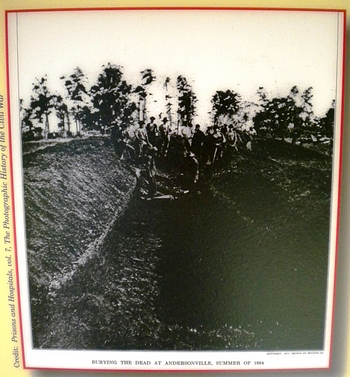 There was a fellow prisoner named Dorence Atwater who was a close friend of the first one
who died (Adam Swarner) and he volunteered to keep the records. He wanted to make sure
that those who died here were remembered and so the families would know the fate and
burial place of their loved ones. When the dead were brought out of the stockade to
the "Deadhouse" they were brought by friends who knew them. They would report what was
known about the dead man such as name, State, Regiment, date of death, cause, etc.
Atwater recorded them numerically and attached a tag to the body which matched the number
in the records. The dead then were taken to the cemetery where the first dozen were
buried in pine boxes, however since the numbers dying each day was growing so fast, and
limited resources, the dead were stripped naked so the living could use what the dead no
longer needed. The bodies were then laid in trench type graves dug 4 feet deep and long
enough for 150 to 200 bodies and shoulder to shoulder without coffins.
There was a fellow prisoner named Dorence Atwater who was a close friend of the first one
who died (Adam Swarner) and he volunteered to keep the records. He wanted to make sure
that those who died here were remembered and so the families would know the fate and
burial place of their loved ones. When the dead were brought out of the stockade to
the "Deadhouse" they were brought by friends who knew them. They would report what was
known about the dead man such as name, State, Regiment, date of death, cause, etc.
Atwater recorded them numerically and attached a tag to the body which matched the number
in the records. The dead then were taken to the cemetery where the first dozen were
buried in pine boxes, however since the numbers dying each day was growing so fast, and
limited resources, the dead were stripped naked so the living could use what the dead no
longer needed. The bodies were then laid in trench type graves dug 4 feet deep and long
enough for 150 to 200 bodies and shoulder to shoulder without coffins.
With the lack of resources to make grave markers, there was a small post placed at the
head of each grave with a number carved into it. This number matched the one on the body
tag, which matched Atwaters records.
When Dorence Atwater and Miss Clara Barton returned after the war to establish the new
National Cemetery in July 1865, they simply had to match the numbers on the post with
the copy of the list that Atwater smuggled out when he was exchanged. This way, the
identified graves show exactly who is buried where. The post were replaced with wooden
headboards.
In 1878, the wooden boards were replaced by the first set of stones which were plain
smooth stones with the name and grave number.
In 1898 when the US Government finally got around to establishing a standard grave marker
for Union soldiers, there were new stones placed in 1898-1899 to replace the first
stones. These stones now are the ones that mark the graves. So you see, each time the
replaced the marker with a new one, it was easy enough to know who was buried where.
Those who are buried as unknown will remain as such because there will be no way for
anyone but God to know who lies beneith the unknown stones.
(Source: Kevin Frye, Frye@pstel.net)
1850 Census:
Name: Norris Boatright
Date: November 29, 1850
Age: 14
Estimated birth year: abt 1836
Birth place: Tennessee
Gender: Male
Home in 1850
(City,County,State): District 16, Henderson County, Tennessee
Page: 224
Roll: M432_883
1860 Census:
Name: A Boatwright
Date: September 18, 1860
Age in 1860: 25
Birthplace: Tennessee
Home in 1860: District 20, Henderson, Tennessee
Gender: Male
Value of real estate: $0
Post Office: Lexington
Roll: M653_1256
Page: 327
Year: 1860
Head of Household: Tm Boatwright
U.S. Veterans Gravesites, ca.1775-2006
Name: Ananias Boatwright
Service Info.: SGT A 7 TENN CAV
Death Date: 27 Jun 1864
Cemetery: Andersonville National Historical Site
Cemetery Address: Route 1, Box 800 Andersonville, GA 31711
Buried At: Site 2555
Notes for SARAH A. GARNER:
It is my "best guess" that Sarah was the wife of Ananias - George Boatright.
1860 Census:
Name: S A Garner
Date: September 18, 1860
Age in 1860: 14
Birth Year: abt 1846
Birthplace: Tennessee
Home in 1860: District 20, Henderson, Tennessee
Gender: Female
Post Office: Lexington
Census Place: District 20, Henderson, Tennessee;
Roll M653_1256; Page: 326; Image: 297;
Family History Library Film: 805256.
1870 Census:
Name: Sarah L J Boatright
Date: August 22, 1870
Birth Year: abt 1846
Age in 1870: 24
Birthplace: Tennessee
Home in 1870: District 20, Henderson, Tennessee
Race: White
Gender: Female
Post Office: Lexington
Census Place: District 20, Henderson, Tennessee;
Roll M593_1537; Page: 189A; Image: 364;
Family History Library Film: 553036.
Living with parents
1880 Census:
Name: Sarah Boatright
Date: June 5, 1880
Home in 1880: Benton, Dallas, Missouri
Age: 35
Estimated birth year: abt 1845
Birthplace: Tennessee
Relation to Head of Household: Daughter
Father's birthplace: Carolina
Mother's Name: Rachel
Mother's birthplace: Kentucky
Occupation: Works In House
Marital Status: Widowed
Race: White
Gender: Female
Census Place: Benton, Dallas, Missouri;
Roll T9_684; Family History Film: 1254684; Page: 332.4000;
Enumeration District: 26; Image: 0328.
living with mother
1900 Census:
Name: Sarah Boatwright
Date: June 14, 1900
Home in 1900: Center, Hickory, Missouri
Age: 55
Birth Date: Jul 1844
Birthplace: Tennessee
Race: White
Gender: Female
Relationship to Head of House: Mother
Father's Birthplace: N Carolina
Mother's Birthplace: Kentucky
Mother: number of living children: 4
Mother: How many children: 6
Marital Status: Widowed
Residence : Center Township, Hickory, Missouri
Census Place: Center, Hickory, Missouri;
Roll T623_858; Page: 7A;
Enumeration District: 94.
Children of ANANIAS BOATWRIGHT and SARAH GARNER are:
9-280A. i. WILLIAM I. BOATWRIGHT, b. 1861, Henderson County, Tennessee.
9-280B. ii. MARGARET A. BOATWRIGHT, b. 1863, Henderson County, Tennessee.
8-130. GEORGE W. BOATWRIGHT (THOMAS8, JACOB7, WILLIAM6, THOMAS5, JOHN4, JOHN3, JOHN2, Not Yet Determined1) was born
1840 in Henderson County, Tennessee, and died 14 May 1924 in Savannah, Hardin County, Tennessee.
He married MOLLIE. She was born 1852 in Tennessee.
Notes for GEORGE W. BOATWRIGHT:
See link for copy of death certificate.
1850 Census:
Name: George W Boatright
Date: November 29, 1850
Age: 10
Estimated birth year: abt 1840
Birth place: Tennessee
Gender: Male
Home in 1850
(City,County,State): District 16, Henderson County, Tennessee
Page: 224
Roll: M432_883
1860 Census:
Name: G W Boatwright
Date: September 18, 1860
Age in 1860: 20
Birthplace: Tennessee
Home in 1860: District 20, Henderson, Tennessee
Gender: Male
Value of real estate: $0
Post Office: Lexington
Roll: M653_1256
Page: 327
Year: 1860
Head of Household: Tm Boatwright
1900 Census:
Name: Geo W Boatright
Date: June 19, 1900
Home in 1900: Civil District 4, Hardin, Tennessee
Age: 52
Birth Date: Feb 1848
Birthplace: Illinois
Race: White
Gender: Male
Relationship to Head of House: Head
Spouse's name: Mollie
Marriage Year: 1867
Marital Status: Married
Years Married: 33
Occupation: Farm Hand
Residence : Civil District 4 (South Part), Hardin, Tennessee
Census Place: Civil District 4, Hardin, Tennessee;
Roll T623_1576; Page: 13A;
Enumeration District: 33.
1910 Census:
Name: George W Boatwright
Date: May 2, 1910
Age in 1910: 67
Estimated birth year: abt 1843
Birthplace: Tennessee
Relation to Head of House: Head
Father's Birth Place: Alabama
Mother's Birth Place: Tennessee
Home in 1910: Civil District 4, Hardin, Tennessee
Marital Status: Widowed
Occupation: Farmer
Race: White
Gender: Male
Census Place: Civil District 4, Hardin, Tennessee;
Roll T624_1504; Page: 14A;
Enumeration District: 75; Image: 696.
1920 Census:
Name: George W Boatright
Date: February 11, 1920
Home in 1920: Civil District 4, Hardin, Tennessee
Age: 78 years
Estimated birth year: abt 1842
Birthplace: Alabama
Relation to Head of House: Father
Father's Birth Place: United States of America
Mother's Birth Place: United States of America
Marital Status: Widow
Race: White
Sex: Male
Able to read: No
Able to Write: No
Census Place: Civil District 4, Hardin, Tennessee;
Roll T625_1744; Page: 22B;
Enumeration District: 75; Image: 983.
living with son Lee and family
Tennessee, Death Records, 1908-1958
Name: George Boatright
Gender: Male
Birth Date: abt 1841
Birth Place: Alabama
Age: 83
Death Date: 14 May 1924
Death Place: Savannah, Hardin, Tennessee
Certificate Number: 313
Notes for MOLLIE:
1900 Census:
Name: Mollie Boatright
Date: June 19, 1900
Home in 1900: Civil District 4, Hardin, Tennessee
Age: 48
Birthplace: Tennessee
Race: White
Gender: Female
Relationship to Head of House: Wife
Father's Birthplace: Tennessee
Mother's Birthplace: Tennessee
Mother: number of living children: 4
Mother: How many children: 8
Spouse's name: Geo W
Marriage Year: 1867
Marital Status: Married
Years Married: 33
Residence : Civil District 4 (South Part), Hardin, Tennessee
Census Place: Civil District 4, Hardin, Tennessee;
Roll T623_1576; Page: 13A;
Enumeration District: 33.
Child of GEORGE BOATWRIGHT and MOLLIE is:
9-280C. i. JENNIE BOATRIGHT, b. Oct 1888, Tennessee;
9-280D. ii. LEE BOATRIGHT, b. 11 Mar 1893, Tennessee;
d. Apr 1971 in Savannah, Hardin County, Tennessee.
8-131. CHARLES M. BOATWRIGHT (THOMAS8, JACOB7, WILLIAM6, THOMAS5, JOHN4, JOHN3, JOHN2, Not Yet Determined1) was born
1843 in Henderson County, Tennessee.
Notes for CHARLES M. BOATWRIGHT:
1850 Census:
Name: Charles Boatright
Date: November 29, 1850
Age: 6
Estimated birth year: abt 1844
Birth place: Tennessee
Gender: Male
Home in 1850
(City,County,State): District 16, Henderson County, Tennessee
Page: 224
Roll: M432_883
1860 Census:
Name: C M Boatwright
Date: September 18, 1860
Age in 1860: 17
Birthplace: Tennessee
Home in 1860: District 20, Henderson, Tennessee
Gender: Male
Value of real estate: $0
Post Office: Lexington
Roll: M653_1256
Page: 327
Year: 1860
Head of Household: Tm Boatwright
8-132. NANCY M. BOATWRIGHT (THOMAS8, JACOB7, WILLIAM6, THOMAS5, JOHN4, JOHN3, JOHN2, Not Yet Determined1) was born
1846 in Henderson County, Tennessee.
Notes for NANCY M. BOATWRIGHT:
1850 Census:
Name: Nancy M Boatright
Date: November 29, 1850
Age: 4
Estimated birth year: abt 1846
Birth place: Tennessee
Gender: Female
Home in 1850
(City,County,State): District 16, Henderson County, Tennessee
Page: 224
Roll: M432_883
1860 Census:
Name: N M Boatwright
Date: September 18, 1860
Age in 1860: 14
Birthplace: Tennessee
Home in 1860: District 20, Henderson, Tennessee
Gender: Female
Value of real estate: $0
Post Office: Lexington
Roll: M653_1256
Page: 327
Year: 1860
Head of Household: Tm Boatwright
8-133. JOSEPH BOATRIGHT (JACOB8, JACOB7, WILLIAM6, THOMAS5, JOHN4, JOHN3, JOHN2, Not Yet Determined1) was born
1821 in Tennessee, and died Bef. 1830 in Missouri.
8-134. ELIZABETH BOATRIGHT (JACOB8, JACOB7, WILLIAM6, THOMAS5, JOHN4, JOHN3, JOHN2, Not Yet Determined1) was born
07 Jun 1825 in Henderson County, Tennessee, and died 29
Jul 1913 in Marshall, Saline County, Missouri. She married WILLIAM KEYTON 1842 in
Saline County, Missouri. He was born in Virginia.
Notes for ELIZABETH BOATRIGHT:
Burial: Ridge Park Cemetery of Marshall, Saline County, Missouri
Children of ELIZABETH BOATRIGHT and WILLIAM KEYTON are:
i. JOHN KEYTON, b. 1843.
ii. HENRY KEYTON, b. 1846.
8-135. MARGARET D. BOATRIGHT (JACOB8, JACOB7, WILLIAM6, THOMAS5, JOHN4, JOHN3, JOHN2, Not Yet Determined1) was born
1827 in Illinois, and died 1884 in Marshall, Saline County,
Missouri. She married JAMES MILTON SMITH 29 Mar 1849 in Saline County, Missouri. He
was born 1829 in Virginia, and died 1853 in Saline County, Missouri.
Notes for MARGARET D. BOATRIGHT:
1860 Census:
Name: Margaret Smith
Date: August 1860
Age in 1860: 32
Birthplace: Illinois
Home in 1860: Miami, Saline County, Missouri
Gender: Female
Value of real estate: $0
Post Office: Marshall
Roll: M653_645
Page: 0
Year: 1860
Head of Household: Jacob Boatright
Children of MARGARET BOATRIGHT and JAMES SMITH are:
i. ROBERT W. SMITH, b. 08 Sep 1851, Saline County, Missouri;
d. 04 Feb 1931, Warrensburg, Johnson
County, Missouri.
ii. JAMES MILTON SMITH, b. May 1854, Saline County, Missouri.
8-136. WILLIAM GREENE BOATRIGHT (JACOB8, JACOB7, WILLIAM6, THOMAS5, JOHN4, JOHN3, JOHN2, Not Yet Determined1) was born
24 Jan 1830 in Boone County, Missouri, and died 27 Jan 1921 in Herndon, Saline County,
Missouri. He married NANCY FRANCES "FANNIE" BUIE 22 Oct 1857 in Sweet Springs, Saline County,
Missouri, daughter of DANIEL BUIE and NANCY BLAKELY. She was born
16 Jan 1839 in Marshall, Saline County, Missouri, and died 29 Dec 1914 in Herndon, Saline
County, Missouri.
 Notes for WILLIAM GREENE BOATRIGHT:
Notes for WILLIAM GREENE BOATRIGHT:
FROM "A Brief sketch of WILLIAM GREENE BOATRIGHT and NANCY FRANCES BOATRIGHT and their Decendents"
by LESLIE GREENE BOATRIGHT
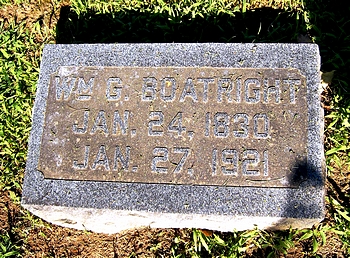 William Greene Boatright was the son of Jacob and Judith Boatright, and was born in Boone
County, Missouri in January 24, 1830. Jacob and Judith, shortly afterwards, moved to Howard
County, then into Saline County, arriving in 1842. They located on a bottom farm north of
Arrow Rock and continued to live in this vicinity until the high waters of 1844 forced them to
seek higher ground. They next located on a farm about six miles northwest of Marshall, in
section 15, township 51, range 21, now known as the "Spicer Farm". There Jacob and Judith
reared their family of eight children. Jacob and Judith died of pneumonia at this home place.
They are buried in the Mt. Carmel Cemetery, north of Marshall.
William Greene Boatright was the son of Jacob and Judith Boatright, and was born in Boone
County, Missouri in January 24, 1830. Jacob and Judith, shortly afterwards, moved to Howard
County, then into Saline County, arriving in 1842. They located on a bottom farm north of
Arrow Rock and continued to live in this vicinity until the high waters of 1844 forced them to
seek higher ground. They next located on a farm about six miles northwest of Marshall, in
section 15, township 51, range 21, now known as the "Spicer Farm". There Jacob and Judith
reared their family of eight children. Jacob and Judith died of pneumonia at this home place.
They are buried in the Mt. Carmel Cemetery, north of Marshall.
William Greene Boatright purchased 40 acres from the original (Jacob and Judieth Boatright)
homestead on May 15, 1852. See link for copy of
Land Office Record.
William Greene Boatright purchased 40 acres on June 27, 1852 from his sister Margaret and her
husband, James M. Smith. The document is dated "1842" but that is in error, as Margaret and
James Smith did not wed until 1849 and William would have been 12 years old in 1842. See link
for copy of 1852 Land Purchase Record.
William Greene Boatright purchased 160 acres in Lafayette County, Missouri (west of Saline
County) on May 1, 1857.
See link for copy of Land Office and Purchase Records.
William Greene Boatright sold 40 acres in Saline County, Missouri April 25, 1858.
See link for copy of Land Sale in 1858.
William Greene Boatright purchased 200 acres from William Liles and his wife on May 17, 1861.
See link for copy of Land Purchase in 1861.
William Greene Boatright sold 20 acres in Saline County, Missouri in 1868.
See link for copy of Land Sale in 1868.
William Greene Boatright sold 42 acres in Saline County, Missouri in 1912.
See link for copy of Land Sale in 1912.
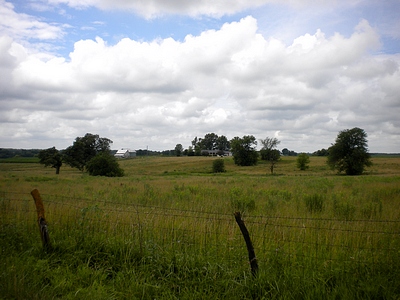 William Greene Boatright purchased a farm northwest of Herndon in section 23, township 49,
range 22, now known as the "Schrader Farm". Shortly after taking possession of this farm,
William went to an old-fashioned revival meeting, which in those days was held in a shady
grove, and while at this meeting Nancy Buie rode up on her horse. William made the remark
to someone by who he was standing that "there was a gal he was sure going to get acquainted
with before he went home". After the services were over William had his horse and had
untied Nancy's horse and was waiting to assist her to mount. It could have been because
William always wore a smile or it might have been because of Nancy's red hair, but this
proved to be love at first sight and they were married on October 22, 1857, at the home of Mrs.
Nancy Buie and the Rev. James Martin.
William Greene Boatright purchased a farm northwest of Herndon in section 23, township 49,
range 22, now known as the "Schrader Farm". Shortly after taking possession of this farm,
William went to an old-fashioned revival meeting, which in those days was held in a shady
grove, and while at this meeting Nancy Buie rode up on her horse. William made the remark
to someone by who he was standing that "there was a gal he was sure going to get acquainted
with before he went home". After the services were over William had his horse and had
untied Nancy's horse and was waiting to assist her to mount. It could have been because
William always wore a smile or it might have been because of Nancy's red hair, but this
proved to be love at first sight and they were married on October 22, 1857, at the home of Mrs.
Nancy Buie and the Rev. James Martin.
Nancy Frances Buie, the youngest daughter of Daniel and Nancy Buie, was born January 16,
1839, on a farm about seven miles south of Marshall. Daniel Buie, her father, was said to be
the first Presbyterian preacher west of the Mississippi River. He lost his health in preaching
and died in a sanitarium in Fulton, Missouri. Nancy mother was born September 21, 1803 and
died August 20, 1871, and was buried in the Mount Olive Cemetery near her old home place.
William and Nancy went immediately to housekeeping on the farm William had purchased
northwest of Herndon. They continued on this farm until the outbreak of the Civil War.
William realized that he would soon have to go to the army and being in debt on this farm,
deemed it wise and best to sell and buy a smaller farm for which he could pay. He disposed of
the original farm and purchased 160 acres just east of his first farm. Shortly after moving to
this second farm William joined the Confederate Army under General Price's command.
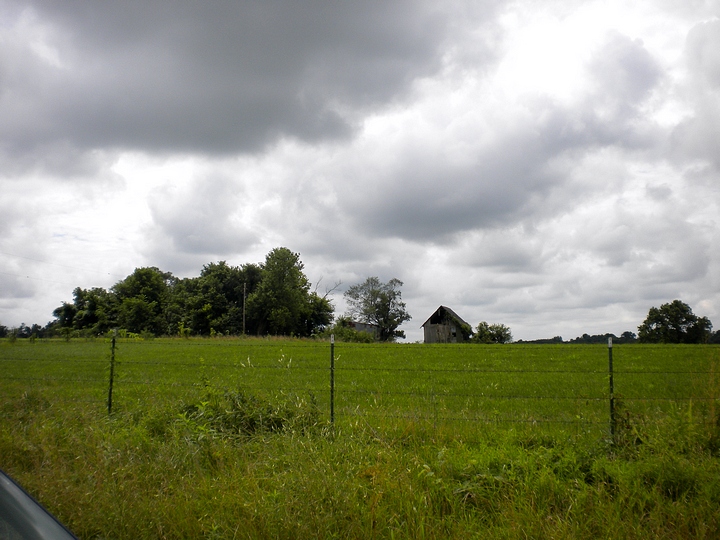
William Greene Boatright Farm purchased during the Civil War
Click on link for more photos of the William Greene Boatright Farm
When William left home he said he was riding a good grey horse but he decided that this horse
could be seen too easily and he traded him off for a horse of a different color. William was in
the army about one year but was in no real battles but suffered many hardships. On one
occasion he told of being so hungry that he tried to kill the captain's dog to eat. On another
occasion, he told of the army moving camp, he was riding behind a wagon with a sick man
lying down. He followed this wagon for about a half day and finally someone told him the
man had smallpox. William was mustered out of the service after a year of duty.
When William left for the army he was 31 years old and Nancy was 22. He left Nancy at
home with two babies and a negro woman whose name was Moth. Moth had a little boy
eleven years old named Jack. A few months after he left for the army a third child was born to
Nancy. The hardships that Nancy had to endure were something awful. She had to
superintend the work of plowing and planting the ground and the making of fences which, in
those days, were made of rails. Nancy often said that she got along very well during the day
time when she was at work, but after supper she got to thinking of William and could not keep
from crying. Moth, the negro woman, was a smoker and she persuaded my mother to try it.
Moth told Nancy it would help her to forget her troubles. Nancy formed the habit of smoking
and never did quit it. Nancy smoked a little clay pipe and always smoked after each meal.
William returned from the army and they lived the remainder of their lives on this same farm,
which was 57 years of married life. Nancy died of pneumonia on December 29, 1914, she was
75 years old. William died of pneumonia on January 27, 1921, 3 days after his 91st birthday.
See link for copy of death certificate.
See link for copy of William Greene Boatright Will.
See link for copy of William Greene Boatright Estate Papers.
They were buried in Ridge Park Cemetery in Marshall,
Saline County, Missouri.
From History of Saline County 1881:
William G. Boatright was born in Boone County, Missouri, in 1830, and at an early age moved
with his parents to Cooper County, then to Howard County, and finally to Saline County, in
1840, and settled near Arrow Rock. In 1844 the stress of river waters drove him out of the
bottom and onto the prairie. He next moved to the vicinity of Miami, where he lived until
1857, when he moved to the place on which he now lives. In 1857 he was married to Miss
Fannie Buie, daughter of Daniel Buie, a C. P. Preacher, said to have been the first in the state.
He has ten children, all living: John W., Lewis, Finis H., George F., Mary F., Charles R.,
Annie, Inez, Callie and Leslie. Mr. Boatright is a member of the M. E. Church, South, with
membership at Hazel Grove Church. During the war he entered the Confederate service, in
Marmaduke's escort, and then in the 10th Missouri cavalry. He started in life with nothing, but
by his industry and management has now a fine farm of 200 acres, well stocked and improved.
Served in CSA, Private, 10th Regiment, Missouri Cavalry.
10th Cavalry Regiment was organized in December, 1863, using M.L. Young's 11th Missouri
Cavalry Battalion as its nucleus. It contained 559 officers and men. The unit served in C.
Greene's and J.B. Clarke's Brigade, Trans-Mississippi Department, and skirmished in
Arkansas and saw action in Price's Missouri Expedition. During this operation it reported 16
killed, 56 wounded, and 73 missing. The regiment was included in the surrender in June, 1865.
Its commanders were Colonel Robert R. Lawther, Lieutenant Colonel Merritt L. Young, and
Major George W.C. Bennett.
Article in the Marshall, Weekly Democrat-News, Thursday, February 3, 1921:
Funeral from Home
Six Grandsons of Mr. Boatright Served as Pall Bearers
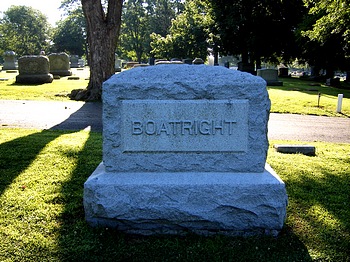
The service over the remains of the late W. G. Boatright, was held Saturday morning at the
Boatright country home near Herndon at 11:30. There was a large concourse of friends and
neighbors present to pay a loving tribute to one during his long and useful life had gained the
esteem of all who knew him. Rev. Mr. Brooks of Longwood conducted the service and
several sweet old hymns were sung by a neighborhood choir. After the service the remains
were brought to Ridge Park Cemetery for interment on the Boatright lot. An interesting thing
relative to the funeral was that six of the grandsons of the aged grandfather served as pall
bearers. They were: Harry, Thomas, Dean and Frank of the county, and William Boatright and
William Maupin of Kansas City.
1850 Census:
Name: William Boatright
Date: September 28, 1850
Age: 20
Estimated birth year: abt 1830
Birth place: Missouri
Gender: Male
Home in 1850
(City,County,State): District 90, Saline County, Missouri
Page: 25
Roll: M432_419
U.S. General Land Office Records, 1796-1907
Name: William G Boatright
Issue Date: 15 May 1852
State of Record: Missouri
Acres: 40
Accession Number: MO1630__.285
Metes and Bounds: No
Land Office: Clinton
Canceled: No
US Reservations: No
Mineral Reservations: No
Authority: April 24, 1820: Sale-Cash Entry (3 Stat. 566)
Document Number: 32177
Legal Land Description: Section 15; Twp - 51-N; Range - 21-W;
Meridian - 5th PM; County - Saline
U.S. General Land Office Records, 1796-1907
Name: William G Boatright
Issue Date: 1 May 1857
State of Record: Missouri
Acres: 160
Comments: ADD CERT #41014
Accession Number: MO1880__.290
Metes and Bounds: No
Land Office: Warsaw
Canceled: No
US Reservations: No
Mineral Reservations: No
Authority: April 24, 1820: Sale-Cash Entry (3 Stat. 566)
Document Number: 41013
Legal Land Description: Section - 11; Twp - 48-N; Range - 27-W;
Meridian - 5th PM; County - Lafayette
1860 Census:
Name: Wm G Boatright
Date: June 1860
Age in 1860: 30
Birthplace: Missouri
Home in 1860: Salt Pond, Saline County, Missouri
Occupation: Farmer
Gender: Male
Value of real estate: $2,000
Post Office: Marshall
Roll: M653_645
Page: 0
Year: 1860
Head of Household: Wm G Boatright
U.S. Civil War Soldiers, 1861-1865
Name: William G. Boatright
Side: Confederate
Regiment State/Origin: Missouri
Regiment Name: 10 Missouri Cavalry
Regiment Name Expanded: 10th Regiment, Missouri Cavalry
Company: A
Rank In: Private
Rank In Expanded: Private
Rank Out: Private
Rank Out Expanded: Private
Film Number: M380 roll 2
1870 Census:
Name: W G Boatright
Date: June 22, 1870
Estimated Birth Year: abt 1830
Age in 1870: 40
Birthplace: Missouri
Home in 1870: Salt Pond, Saline, Missouri
Occupation: Farmer
Race: White
Gender: Male
Value of real estate: $3,200
Post Office: Brownsville
Roll: M593_804
Page: 252
Image: 506
Year: 1870
1880 Census:
Name: William BOATRIGHT
Date: June 1, 1880
Age: 50
Estimated birth year: 1830
Birthplace: Missouri
Occupation: Farmer
Relationship to head-of-household: Self
Home in 1880: Liberty, Saline, Missouri
Marital status: Married
Race: White
Gender: Male
Spouse's name: Nancy F. BOATRIGHT
Father's birthplace: SC
Mother's birthplace: SC
Census Place: Liberty, Saline, Missouri;
Roll: T9_716; Family History Film: 1254716; Page: 532A;
Enumeration District: 68; Image: 0352.
1900 Census:
Name: Wm Boatright
Date: June 7, 1900
Home in 1900: Liberty, Saline, Missouri
Age: 70
Estimated birth year: 1830
Birthplace: Missouri
Race: White
Relationship to head-of-house: Head
Occupation: Farmer
Census Place: Liberty, Saline, Missouri;
Roll: T623 902; Page: 4A;
Enumeration District: 129.
1910 Census:
Name: William G Boatright
Date: May 5, 1910
Age in 1910: 80
Estimated birth year: abt 1830
Birthplace: Missouri
Home in 1910: Liberty Twp, Saline, Missouri
Occupation: Farmer
Race: White
Gender: Male
Series: T624
Roll: 823
Part: 2
Page: 167B
1920 Census:
Name: William G Boatright
Date: January 3, 1920
Age: 89 years
Estimated birth year: abt 1831
Birthplace: Missouri
Race: White
Home in 1920: Liberty, Saline, Missouri
Able to read & write: Yes
Roll: T625_962
Page: 2 A
ED: 196
Image: 325
Burial: 29 Jan 1921 - Ridge Park Cemetery of Marshall, Saline County, Missouri
 Notes for NANCY FRANCES "FANNIE" BUIE:
Notes for NANCY FRANCES "FANNIE" BUIE:
Memories of Leslie Green Boatright (son of William and Nancy Boatright):
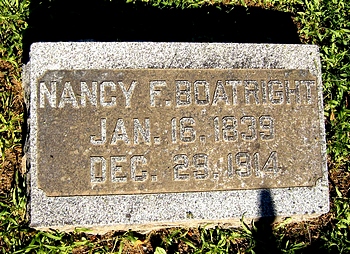 "I often think of the work it required to produce some of the food which was essential in
feeding our family (11 children). To have a barrel of sorghum each fall meant that we had to
grow some cane. This meant hoeing, thinning, plowing, stripping the blades from the stalks
and finally cutting the cane stalks and hauling them to a mill where the juice was pressed from
the stalks and then cooked into sorghum molasses. And in addition to all this work, the man
who cooked the sorghum retained one-half of what he made for his work.
"I often think of the work it required to produce some of the food which was essential in
feeding our family (11 children). To have a barrel of sorghum each fall meant that we had to
grow some cane. This meant hoeing, thinning, plowing, stripping the blades from the stalks
and finally cutting the cane stalks and hauling them to a mill where the juice was pressed from
the stalks and then cooked into sorghum molasses. And in addition to all this work, the man
who cooked the sorghum retained one-half of what he made for his work.
Gathering the apples in the fall of the year was another hard task. The apples were first picked
from the trees and placed in piles in the orchard, later to be sorted. The number one's were
stored for winter use. This was done by digging a hole in the ground and covering the apples
with straw and dirt. The apples kept in this manner until late spring. The number two's were
pealed for apple butter. The apples were cooked in a large kettle in the yard. These apples
were seasoned with sweet cider and sorghum molasses. Someone had to stir the apples all the
time they were cooking to keep them from sticking to the kettle. Nancy used to drop three or
four silver dollars in the kettle of apples. She thought they kept the apple butter from sticking
to the bottom of the kettle. The cull apples were ground into cider by crushing them in the
mill, which we turned by hand. Later the juice was squeezed from the pulp, and I have never
been able to tell which I enjoyed the most, drinking the sweet cider and eating molasses
cookies or eating sorghum molasses and butter on a hot biscuit.
Butchering the meat hogs each fall meant more hard work. This work was usually done the
week before Christmas, provided the weather and the moon were right. We used to think if we
could butcher a hog for each member of the family, we would have meat enough to last us. It
usually took about six days to butcher the hogs, cook the grease and grind the sausage. The
sausage was ground in a small mill turned by hand, which had two rows of knives on each side
that cut the meat in small pieces, and it sure did make good red gravy.
I think I enjoyed seeing the steam engine come in pulling the separator to thresh our wheat
more than anything else. It usually took about twenty five men to operate the threshing
machine, and they were usually there from two to three days. Nancy had to give all these men
their meals, but most of them went to their own homes after supper. I think cooking for this
threshing crew was the hardest ordeal that she had to contend.
Nancy knew nothing of modern conveniences. The water for the family washing was drawn
from the well with a rope and bucket and carried into the kitchen in tubs and buckets. Nancy
had a large flock of tame geese from which she plucked the feathers at regular intervals and
made each child a feather bed. The butter was produced from cream that was kept in a tall
stone jar and stirred with a wooden paddle until the cream had turned to butter. One hundred
pounds of flour would last about ten days and this was made into biscuits and eaten by the
hungry children. As a seamstress, Nancy made dresses, aprons, petticoats, sunbonnets with
the brim reinforced with pasteboard strips, shirts, trousers, coats, underwear, and sometimes
the children's caps, pieced quilts, tacked comforts, knitted gloves, socks and stockings and
made the soap for the family's use. Nancy stored all the vegetables and fruit she could obtain.
One summer she canned fifty gallons of peaches. Nancy made a manufacturing industry of
this farm to be consumed by her family."
Article in the Marshall, Weekly Democrat-News, Thursday, December 31, 1914:
Mrs. Nancy Frances Boatright
Wife of Wm. G. Boatright, Died at home near Herndon, at 1:30am, Tuesday, December 29,
1914.
Mrs. Wm. G. Boatright, 75 years, 11 months and 13 days old, died at her home near Herndon,
Tuesday morning, December 29, 1914, after an illness of about two weeks of pneumonia.
Mrs. Boatright who was Miss Frances Buie, was the daughter of the late Daniel Buie, a
pioneer Cumberland Presbyterian minister. She was married to the surviving husband in 1857,
who is 80 years old and was a member of Marmaduke's escort, 10th Missouri Cavalry, during
the Civil War.
The Boatright family has been identified with Saline county interests for the past 57 years.
Mr. and Mrs. Boatright have lived in their farm in the Herndon neighborhood since their
marriage, and ten children were born to the union of which the following survive: Miss Mary
Boatright, who lives at home; L. G. Boatright of Herndon; Finis H. Boatright of Marshall; G.
F. Boatright, Sedalia; C. R. Boatright, San Francisco, Mrs. O. T. Diehl, Trenton, North
Dakota; Mrs. J. B. Finley, of near Houstonia; Mrs. S. J. Maupin, Kansas City.
Mr. Thomas Boatright of Marshall is a brother-in-law of the deceased.
Mrs. Boatright who was a member of the Hazel Grove church at Herndon, was a woman of the
highest ideals. Her father is said to have been the first Cumberland minister in the state.
The funeral took place at the home, two miles northwest of Herndon, Wednesday at 10 a.m.,
and Rev. G. L. Coffman of Sweet Springs had charge of the services. Burial was in Ridge
Park cemetery.
P. M. Walker has charge of funeral arrangements.
Article in the Marshall, Weekly Democrat-News, Thursday, March 4, 1915
In Memory of the Late Mrs. W. G. Boatright
Mrs. Nancy Frances, wife of W. G. Boatright who died of pneumonia on December 29, 1914,
at 1:30 a.m., at her home near Herndon, where she has lived over fifty years, was born January
16, 1839, near Mt. Olive church, was married October 22, 1857. A brief funeral service was
held at residence, burial at Ridge Park.
The deceased leaves to mourn her loss an aged and devoted husband and 9 children: John W.
of Herndon neighborhood, Finis H. of Marshall, Geo. F. of Pettis county, Chas. R. of
California, Miss Mary of the home, Mrs. O. T. Diehl, North Dakota, Mrs. S. J. Maupin,
Kansas City; Leslie G. of Herndon neighborhood; two are dead, Louis, who died in 1912, and
the baby, Jesse Lee, who died in 1884.
She was the youngest daughter of Rev. D. D. Buie, who was said to be the first Cumberland
Presbyterian preacher in the state.
Our hearts were made sad by the calling of this good woman home.
At an early age she gave her heart to God at a Baptist camp-meeting, uniting with this church,
but after her marriage she went with her husband to the Methodist church, they being charter
members of the M. E. church at Herndon. Her long years of loyalty, devotion, and activity in
His service have proved the sincerity of her profession. She loved her church, was a consistant
and faithful member, a regular attendant until age crept on. Truly it can be said her home was
a home for the minister, many will recall the hearty welcome she gave them. Her life was full
of good deeds, always ready to minister to the sick and afflicted. Not only will she be greatly
missed in the home, but by all who knew her. None knew her but to love her.
She had been a great sufferer for years but bore it with Christian fortitude. When God called
she was ready and anxious to go. In her last sickness she was unable to speak, but two years
ago, when seemingly her life was suspended by a thread, she made all arrangements to go;
assured her family she had no fears of death; often spoke of how sweet it would be to go home
to Heaven. Her only regret was leaving her husband, who she had so tenderly cared for the
past 57 years.
If her loved ones could draw back the certain, they would not ask mother to return to this
sinful world. Her departure to be with Christ has left a vacancy only to be compensated by the
indwelling presence of the spirit and comforting grace of Christ, who doeth all things well.
By her kind gentle manner and devotion to her family, she made home bright and attractive
and her wise counsel and strong Christian character were such a help and inspiration in the
home, that lovingly they all clung to her to the end.
"No longer we'll wander in darkness and night,
We will walk in that city where God is the light;
My loved ones will wait at the harbor for me
To welcome me home where from sin I'll be free.
No sickness, no sorrow, no pains as before;
With joy we'ss commune with our friends as of yore,
A rapture unspeakable then shall be mine,
As there I behold him so pure and divine.
A halo of glory will shadow us o'er
With joy we will sing on that far away shore.
There happy we'll be for the Lord we shall see,
When the beautiful gates unfold."
(dwit)
See link for copy of death certificate.
1860 Census:
Name: Nancy Boatright
Date: June 1860
Age in 1860: 21
Birthplace: Missouri
Home in 1860: Salt Pond, Saline County, Missouri
Gender: Female
Value of real estate: $0
Post Office: Marshall
Roll: M653_645
Page: 0
Year: 1860
Head of Household: Wm G Boatright
1870 Census:
Name: Nancy F Boatright
Date: June 22, 1870
Estimated Birth Year: abt 1839
Age in 1870: 31
Birthplace: Missouri
Home in 1870: Salt Pond, Saline, Missouri
Race: White
Gender: Female
Value of real estate: $0
Post Office: Brownsville
Roll: M593_804
Page: 252
Image: 506
Year: 1870
1880 Census:
Name: Nancy F. BOATRIGHT
Date: June 1, 1880
Age: 41
Estimated birth year: <1839>
Birthplace: Missouri
Relationship to head-of-household: Wife
Home in 1880: Liberty, Saline, Missouri
Marital status: Married
Race: White
Gender: Female
Spouse's name: William BOATRIGHT
Father's birthplace: KY
Mother's birthplace: KY
Census Place: Liberty, Saline, Missouri;
Roll: T9_716; Family History Film: 1254716; Page: 532A;
Enumeration District: 68; Image: 0352.
1900 Census:
Name: Nancy F Boatright
Date: June 7, 1900
Home in 1900: Liberty, Saline, Missouri
Age: 61
Estimated birth year: 1839
Birthplace: Missouri
Race: White
Relationship to head-of-house: Wife
Census Place: Liberty, Saline, Missouri;
Roll: T623 902; Page: 4A;
Enumeration District: 129.
1910 Census:
Name: Nancy F Boatright
Date: May 5, 1910
Age in 1910: 71
Estimated birth year: abt 1839
Birthplace: Missouri
Home in 1910: Liberty Twp, Saline, Missouri
Race: White
Gender: Female
Series: T624
Roll: 823
Part: 2
Page: 167B
Burial: 30 Dec 1914 - Ridge Park Cemetery of Marshall, Saline County, Missouri
Children of WILLIAM BOATRIGHT and NANCY BUIE are:
9-281. i. JOHN WILLIAM BOATRIGHT, b. 03 Aug 1859, Herndon, Saline County, Missouri;
d. 22 Oct 1938, Herndon, Saline County, Missouri.
9-282. ii. LOUIS BOATRIGHT, b. 03 Oct 1861, Herndon, Saline County, Missouri;
d. 12 Aug 1912, Marshall, Saline County, Missouri.
9-283. iii. FINIS HARVEY BOATRIGHT, b. 23 Mar 1864, Herndon, Saline County, Missouri;
d. 19 Feb 1926, Marshall, Saline County, Missouri.
9-284. iv. GEORGE FRANCIS BOATRIGHT, b. 03 Sep 1866, Herndon, Saline County, Missouri;
d. 10 Mar 1936, Kansas City Jackson County, Missouri.
9-285. v. CHARLES ROBERTSON BOATRIGHT, b. 07 Nov 1869, Herndon, Saline County, Missouri;
d. 12 Sep 1936, San Francisco, San Francisco County, California.
9-286. vi. MARY FRANCES BOATRIGHT, b. 11 Aug 1871, Herndon, Saline County, Missouri;
d. 27 Oct 1931, Herndon, Saline County, Missouri.
9-287. vii. ANNIE BOATRIGHT, b. 25 Dec 1872, Herndon, Saline County, Missouri;
d. Trenton, Williams County, North Dakota.
9-288. viii. INEZ BOATRIGHT, b. 25 Nov 1874, Herndon, Saline County, Missouri;
d. 15 May 1966, Sedalia, Pettis County, Missouri
9-289. ix. SALLIE BOATRIGHT, b. 07 Dec 1876, Herndon, Saline County, Missouri;
d. 02 Nov 1960, Saline County, Missouri.
9-290. x. LESLIE GREENE BOATRIGHT, b. 15 Feb 1880, Herndon, Saline County, Missouri;
d. 05 Dec 1950, Marshall, Saline County, Missouri.
9-291. xi. JESSE LEE BOATRIGHT, b. 27 Jan 1882, Herndon, Saline County, Missouri;
d. 12 Jan 1884, Herndon, Saline County, Missouri.
8-137. ELIZA A. BOATRIGHT (JACOB8, JACOB7, WILLIAM6, THOMAS5, JOHN4, JOHN3, JOHN2, Not Yet Determined1) was born
1835 in Howard County, Missouri. She married JOHN B. CHAMBERLAIN 19 Sep 1869 in
Saline County, Missouri. He was born 1829 in Canada.
Notes for ELIZA A. BOATRIGHT:
1850 Census:
Name: Eliza Boatright
Date: September 28, 1850
Age: 18
Estimated birth year: abt 1832
Birth place: Missouri
Gender: Female
Home in 1850
(City,County,State): District 90, Saline County, Missouri
Page: 25
Roll: M432_419
1860 Census:
Name: Eliza A Boatright
Date: August 1860
Age in 1860: 24
Birthplace: Missouri
Home in 1860: Miami, Saline County, Missouri
Gender: Female
Value of real estate: $0
Post Office: Marshall
Roll: M653_645
Page: 0
Year: 1860
Head of Household: Jacob Boatright
Children of ELIZA BOATRIGHT and JOHN CHAMBERLAIN are:
i. JOHN J. CHAMBERLAIN, b. 1871.
ii. THOMAS F. CHAMBERLAIN, b. 1875.
8-138. THOMAS HART BOATRIGHT (JACOB8, JACOB7, WILLIAM6, THOMAS5, JOHN4, JOHN3, JOHN2, Not Yet Determined1) was born
1836 in Howard County, Missouri, and died 21 Apr 1916 in Marshall, Saline
County, Missouri. He married MARY ELIZABETH HARL, 1885 in Independence,
Jackson County, Missouri, daughter of JOHN HARL and MARY MANNING. She
was born 04 Nov 1840 in Kentucky, and died 03 Dec 1913 in Marshall, Saline County,
Missouri.
Notes for THOMAS HART BOATRIGHT:
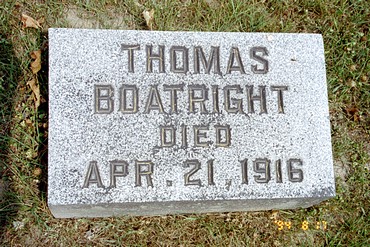
See link for copy of Land Purchase.
See link for copy of Land Sale.
from The History of Saline County 1881:
Thomas Boatright was born in Howard County, Missouri, and was raised in Saline County, having moved
there with his parents when quite young, and was educated at private schools. In 1861, he joined Captain Ed
Brown's company, M. S. G., as private, and served six months. Was at the first battle of Boonesville, Wilson's
Creek, and Lexington. In 1864 he enlisted again, this time in Captain Page's company, in Marmaduke's
escort, as second lieutenant, and was in the battles of Blues, Lexington, Westport, and the many others that
occurred during Price's retreat. He served on to the end of the war, and surrendered in Shreveport, in 1865.
Returned to Saline, and farmed until 1871, then located in Marshall, and engaged in the insurance and real
estate business. In 1878 he was elected city collector, and in 1880 reelected. Is also a notary public, and the
firm is doing an extensive and growing real estate business.
Thomas and Mary Elizabeth did not have children.
See link for copy of death certificate.
See link for copy of Thomas Hart Boatright Will.
See link for copy of Map of Thomas Boatright Addition in Marshall, Missouri.
Saline County Weekly Progress, Friday, April 21, 1916
Thos. H. Boatright Dead
Word has just been received at this office as we go to press that Thomas H. Boatright, an old and honored
citizen of this community, died at his home on North Jefferson Street at 1 o'clock a.m., Friday, April 21st.,
after an illness extending over several weeks, but from which he was thought to be recovering nicely. The
news of his death will come as a great shock to his many friends in the community.
Funeral arrangements have not been made at this time.
A fuller obituary will be given in The Progress next week.
Saline County Weekly Progress, Friday, April 28, 1916
Thomas Hart Boatright, whose unexpected death, we mentioned briefly last week, was 79 years of age when
death came to him unexpectedly at his home on North Jefferson at 12:15 a.m. Friday, April 21st. Mr.
Boatright's death was a great shock to his many friends and acquaintances, as his condition for several days
past had been much better and at no time during his recent illness had he been thought to be in an
immediately dangerous condition. Last fall he fell and sustained a fracture of the hip, but this was more
inconvenient and trying than dangerous. On Thursday he was in his usual spirits, and sat and talked to Mr.
and Mrs. Carter, who occupy his home, until his usual bed time and seemed in the best of spirits. About
midnight Mrs. Carter heard the electric summons bell, which connected from his sleeping room to that of Mr.
and Mrs. Carter, and went at once to his room where she found him suffering from severe pains in the region
of the heart. The doctor, Dr. John M. Berry, was summoned at once, but Mr. Boatright died before Dr. Berry
could administer to him. Death was due to heart trouble.
Mr. Boatright is survived by two brothers, William Boatright of Herndon and John Boatright of Schell City.
His wife died a few years ago, leaving two daughters, step-daughters to Mr. Boatright, to whom he was deeply
attached. One of those, Mrs. Overton B. Gentry of Independence, was here just a week before Mr. Boatright's
death. Upon his death she was summoned at once and came and took charge of the funeral arrangements.
Another, Mrs. Collins Peebles of Washington, D. C., telegraphed that she would not be able to be present at
the funeral.
Mr. Boatright was born in Howard County in 1837, but moved to Saline while yet young. During the Civil
War he served in the Confederate Army and was a Second Lieutenant in the escort of General M. M.
Marmaduke. He took part in most of the battles in Missouri, including those at Marshall, Boonville,
Lexington, Wilson's Creek, Westport and others. At the close of the war, Mr. Boatright returned to Saline and
made his home at Marshall in 1871, having lived on his farm from the close of the war till that time. During
his first residence in Marshall he was engaged in the real estate and insurance business but later on installed
the first gas plant in the city and was the owner and operator of it for a number of years, retiring several years
ago from active business.
In 1885 he married Mrs. Mary Elizabeth Harl-Robertson at the home of her daughter, Mrs. Gentry, in
Independence. She died about two years ago and since then he has lived at their home on North Jefferson,
someone always occupying the house with him.
In Mr. Boatright the community loses a man who figured prominently in its history for many years. He had
many friends, for he merited friendship. Throughout the community he was respected and his unexpected
death was a severe blow to many.
The funeral was conducted at the Christian Church Sunday afternoon at 2:30 by Elder Harvey Baker Smith.
Mr. Boatright was a member of the Methodist church, but had never taken membership in Marshall. His was
a regular attendent of the Christian church, however, and it was a church home to both of them for a number
of years. The Christian church choir sang, "Beautiful Isle of Somewhere," "Abide With Me" and "In the
Sweet Bye and Bye." The funeral was under the auspices of the Masonic fraternity and was escorted to the
cemetery by the Knights of Missouri Commandery in full uniform and a great many members of Trilumina
Lodge, No. 205, A.F. & A.M. The grave was beautifully decorated with the tributes, there being one from
each of the Masonic fraternities. Dr. M.T. Chastain, D. D. Duggins, Judge R.W. Hickman, J. W. Keys and
George Purcell were pall bearers.
1850 Census:
Name: Richmond T Boatright
Date: September 28, 1850
Age: 11
Estimated birth year: abt 1839
Birth place: Missouri
Gender: Male
Home in 1850
(City,County,State): District 90, Saline County, Missouri
Page: 25
Roll: M432_419
1860 Census:
Name: Thos Boatright
Date: September 1860
Age in 1860: 20
Birthplace: Missouri
Home in 1860: Marshall, Saline County, Missouri
Gender: Male
Value of real estate: $0
Post Office: Marshall
Roll: M653_645
Page: 0
Year: 1860
Head of Household: Thos Boatright
1870 Census:
Name: Thomas Boatright
Date: August 8, 1870
Estimated Birth Year: abt 1836
Age in 1870: 34
Birthplace: Missouri
Home in 1870: Miami, Saline, Missouri
Occupation: Farmer
Race: White
Gender: Male
Value of real estate: $2,000
Post Office: Marshall
Roll: M593_804
Page: 209
Image: 421
Year: 1870
1910 Census:
Name: Thomas Boatwright
Date: April 15, 1910
Age in 1910: 70
Estimated birth year: abt 1840
Birthplace: Missouri
Home in 1910: 2-Wd Marshall, Saline, Missouri
Occupation: Own Income
Race: White
Gender: Male
Series: T624
Roll: 823
Part: 2
Page: 246A
Burial: 25 Apr 1916 - Ridge Park Cemetery of Marshall, Saline County, Missouri
Notes for MARY ELIZABETH HARL:
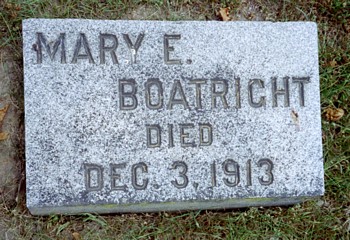
See link for copy of death certificate.
Weekly Democrat-News, Marshall, Thursday, December 11, 1913
Laid in Ridge Park Cemetery - Large Number Attend Funeral of Mrs. Boatright, Despite the Rain
The funeral of Mrs. Thomas Boatright held at the Christian church Friday afternoon at 2 o'clock was an
impressive sweet service.
Eld. B. T. Wharton, who conducted the exercises took the first part of the 14th chapter of John for the basis of
his talk. This scripture lesson was one that Mrs. Boatright loved to dwell upon, especially during her long
illness. Mr. Wharton paid a loving tribute to one whose life had been so inseperably connected with the
church of which he has been pastor for the past fifteen or sixteen years; she had been reared from childhood in
the denomination, her grandfather Harl, who came to Saline in an early day from Kentucky having been a
charter member of Alexander Campbell's church and a leader in the reformation, so the granddaughter had
been singerlarly devoted to the Christian church.
The hyms sung by the church choir were: "Nearer My God to Thee," "Beautiful Isle of Somewhere," and
"Abide With Me." These hymns were also favorites of the deceased and the entire service was a consolation
and comfort to the bereaved ones.
A large number of floral offerings bore silent testimony of love friendship and esteem.
At the close of the service at the church the remains were taken to Ridge Park and laid on the Boatright lot,
neath a canopy of exquisite blossoms, in their purity and beauty typical of the life just ended. One of the
designs was from the Woman's Aid Society of the Christian church.
The pall bearers were: Ed. H. Mitchell, Henry Sherk, J. M. Rose, J. E. McAmis, Ben Striker and H. C.
Francisco.
1910 Census:
Name: Mary E Boatwright
Date: April 15, 1910
Age in 1910: 67
Estimated birth year: abt 1843
Birthplace: Missouri
Home in 1910: 2-Wd Marshall, Saline, Missouri
Race: White
Gender: Female
Series: T624
Roll: 823
Part: 2
Page: 246A
Burial: Ridge Park Cemetery of Marshall, Saline County, Missouri
8-139. JAMES HARVEY BOATRIGHT (JACOB8, JACOB7, WILLIAM6, THOMAS5, JOHN4, JOHN3, JOHN2, Not Yet Determined1) was born
1838 in Howard County, Missouri, and died 12 Aug 1910 in Austin, Travis County, Texas.
Notes for JAMES HARVEY BOATRIGHT:
See link for copy of death certificate.
Served in CSA, 4th Regiment, Missouri Cavalry.
4th Cavalry Regiment was assembled during December, 1861, and included Preston's Missouri Cavalry
Battalion. Some of the men were from St. Louis and Barton County, and many had served in the Missouri
State Guard. The unit served in the Trans-Mississippi Department and was attached to C. Green's, Shelby's,
and J.B. Clarks' Brigade. It participated in Marmaduke's Expedition into Missouri, fought in various conflicts
in Arkansas, and shared in Price's Missouri operations. The regiment reported 11 casualties with Marmaduke,
6 at Poison Spring, 13 at Jenkins' Ferry, and 63 in Price's Expedition. The 4th was included in the surrender in
June, 1865. Colonel John Q. Burbridge, Lieutenant Colonel William J. Preston, and Major Dennis Smith were
its commanders.
1850 Census:
Name: James H Boatright
Date: September 28, 1850
Age: 12
Estimated birth year: abt 1838
Birth place: Missouri
Gender: Male
Home in 1850
(City,County,State): District 90, Saline County, Missouri
Page: 25
Roll: M432_419
1860 Census:
Name: Harvey Boatright
Date: September 1860
Age in 1860: 22
Birthplace: Missouri
Home in 1860: Marshall, Saline County, Missouri
Gender: Male
Value of real estate: $0
Post Office: Marshall
Roll: M653_645
Page: 0
Year: 1860
Head of Household: Thos Boatright
U.S., Civil War Draft Registrations Records, 1863-1865
Name: James H Boatwright
Residence: Miami, Saline, Missouri
Class: 1
Congressional District: 6th
Age on 1 July 1863: 25
Estimated Birth Year: abt 1838
Race: White
Marital Status: Unmarried (Single)
Place of Birth: Missouri
1870 Census:
Name: Harvey Boatright
Date: August 8, 1870
Estimated Birth Year: abt 1838
Age in 1870: 32
Birthplace: Missouri
Home in 1870: Miami, Saline, Missouri
Occupation: Farmer
Race: White
Gender: Male
Value of real estate: $0
Post Office: Marshall
Roll: M593_804
Page: 209
Image: 421
Year: 1870
1910 Census:
Name: J H Boatright
Date: April 18, 1910
Age in 1910: 72
Estimated birth year: abt 1838
Birthplace: Missouri
Relation to Head of House: Inmate
Father's Birth Place: South Carolina
Mother's Birth Place: South Carolina
Home in 1910: Austin Ward 2, Travis, Texas
Marital Status: Single
Race: White
Gender: Male
Census Place: Austin Ward 2, Travis, Texas;
Roll T624_1595; Page: 3A;
Enumeration District: 66; Image: 7.
Living at Confederate Home for Veterans
Texas Deaths Certificate# 1966
Name: J.H. Boatwright
Death Date: 12 Aug 1910
Death Place: Austin, Texas
Gender: Male
Race: White
Death Age: 71 years
Estimated Birth Date: 1839
There was no personal information on this certificate.
He had been an inmate at the Confederate Home for six years.
Burial: Texas State Cemetery, Austin, Travis County, Texas
8-140. HENRY H. BOATRIGHT (JACOB8, JACOB7, WILLIAM6, THOMAS5, JOHN4, JOHN3, JOHN2, Not Yet Determined1) was born
1840 in Howard County, Missouri, and died in Stover, Morgan County, Missouri. He married (1)
MARTHA JANE JONES 14 Jun 1867 in Saline County, Missouri. She was born 1849 in Virginia,
and died 1880. He married (2) EMILY GRACE 26 Mar 1882 in Morgan County, Missouri. She was
born 1851.
Notes for HENRY H. BOATRIGHT:
Served in CSA, 4th Regiment, Missouri Cavalry.
4th Cavalry Regiment was assembled during December, 1861, and included Preston's Missouri
Cavalry Battalion. Some of the men were from St. Louis and Barton County, and many had
served in the Missouri State Guard. The unit served in the Trans-Mississippi Department and
was attached to C. Green's, Shelby's, and J.B. Clarks' Brigade. It participated in Marmaduke's
Expedition into Missouri, fought in various conflicts in Arkansas, and shared in Price's
Missouri operations. The regiment reported 11 casualties with Marmaduke, 6 at Poison
Spring, 13 at Jenkins' Ferry, and 63 in Price's Expedition. The 4th was included in the
surrender in June, 1865. Colonel John Q. Burbridge, Lieutenant Colonel William J. Preston,
and Major Dennis Smith were its commanders.
Henry H. Boatright Deed of Trust in Saline County, Missouri in 1875.
See link for copy of Deed of Trust in 1875.
See link for copy of Land Sales.
1850 Census:
Name: Henry Boatright
Date: September 28, 1850
Age: 10
Estimated birth year: abt 1840
Birth place: Missouri
Gender: Male
Home in 1850
(City,County,State): District 90, Saline County, Missouri
Page: 25
Roll: M432_419
1860 Census:
Name: Henry Boatright
Date: September 1860
Age in 1860: 20
Birthplace: Missouri
Home in 1860: Marshall, Saline County, Missouri
Gender: Male
Value of real estate: $0
Post Office: Marshall
Roll: M653_645
Page: 0
Year: 1860
Head of Household: Thos Boatright
1870 Census:
Name: Henry Boatwright
Date: August 13, 1870
Estimated Birth Year: abt 1840
Age in 1870: 30
Birthplace: Missouri
Home in 1870: Marshall, Saline, Missouri
Race: White
Gender: Male
Value of real estate: $200
Post Office: Brownsville
Roll: M593_804
Page: 166
Image: 333
Year: 1870
Notes for MARTHA JANE JONES:
1870 Census:
Name: Martha Jane Boatwright
Date: August 13, 1870
Estimated Birth Year: abt 1852
Age in 1870: 18
Birthplace: Virginia
Home in 1870: Marshall, Saline, Missouri
Race: White
Gender: Female
Value of real estate: $0
Post Office: Brownsville
Roll: M593_804
Page: 166
Image: 333
Year: 1870
Children of HENRY BOATRIGHT and MARTHA JONES are:
9-292. i. JAMES HENRY BOATRIGHT, b. 19 Mar 1869, Saline County, Missouri;
d. 07 Apr 1957, Versailles, Morgan County,
Missouri.
9-292A. ii. JOHN WILLIAM BOATRIGHT, b. 26 Oct 1873, Saline County, Missouri.
d. 21 Mar 1951, Sedalia, Pettis County, Missouri.
9-292B. iii. IDA J. BOATRIGHT, b. 1874, Saline County, Missouri.
9-292C. iv. THOMAS L. BOATRIGHT, b. 22 Dec 1875, Saline County, Missouri;
d. 14 Sep 1958, Leavenworth, Leavenworth County,
Kansas.
8-141. JOHN G. BOATRIGHT (JACOB8, JACOB7, WILLIAM6, THOMAS5, JOHN4, JOHN3, JOHN2, Not Yet Determined1) was born
27 Sep 1842 in Cooper County, Missouri, and died 15 Aug 1929 in Nevada, Vernon
County, Missouri. He married IDA WHIPS 29 Dec 1872 in Marshall, Saline County,
Missouri, daughter of JOHN WHIPPS and ELIZABETH RUDY. She was born
19 Nov 1851 in Louisville, Jefferson County, Kentucky, and died 16 May 1945 in
Nevada, Vernon County, Missouri.
Notes for JOHN G. BOATRIGHT:
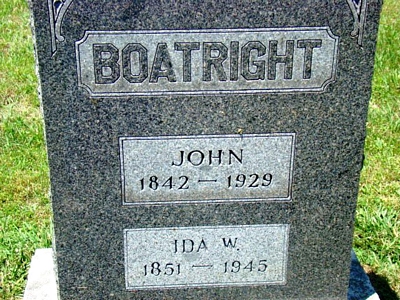
See link for copy of death certificate.
1850 Census:
Name: John Boatright
Date: September 28, 1850
Age: 8
Estimated birth year: abt 1842
Birth place: Missouri
Gender: Male
Home in 1850
(City,County,State): District 90,
Saline County, Missouri
Page: 25
Roll: M432_419
1860 Census:
Name: John G Boatright
Date: August 1860
Age in 1860: 17
Birthplace: Missouri
Home in 1860: Miami, Saline County, Missouri
Gender: Male
Value of real estate: $0
Post Office: Marshall
Roll: M653_645
Page: 0
Year: 1860
Head of Household: Jacob Boatright
1870 Census:
Name: John Boatright
Date: August 8, 1870
Estimated Birth Year: abt 1843
Age in 1870: 27
Birthplace: Missouri
Home in 1870: Miami, Saline, Missouri
Occupation: Farmer
Race: White
Gender: Male
Value of real estate: $0
Post Office: Marshall
Roll: M593_804
Page: 209
Image: 421
Year: 1870
1880 Census:
Name: John BOATRIGHT
Date: June 22, 1880
Age: 34
Estimated birth year: <1846>
Birthplace: Missouri
Occupation: Druggist
Relationship to head-of-household: Self
Home in 1880: Schell City, Vernon, Missouri
Marital status: Married
Race: White
Gender: Male
Spouse's name: Ida BOATRIGHT
Father's birthplace: KY
Mother's birthplace: VA
Census Place: Schell City, Vernon, Missouri;
Roll: T9_739; Family History Film: 1254739; Page: 468D;
Enumeration District: 213; Image: 0439.
1900 Census:
Name: John Boatright
Date: June 4, 1900
Home in 1900: Schell City, Vernon, Missouri
Age: 57
Estimated birth year: 1843
Birthplace: Missouri
Race: White
Relationship to head-of-house: Head
Occupation: Grain Dealer
Census Place: Schell City, Vernon, Missouri;
Roll: T623 906; Page: 4A;
Enumeration District: 116.
1910 Census:
Name: John Boatright
Date: April 18, 1910
Age in 1910: 68
Estimated birth year: abt 1842
Birthplace: Missouri
Home in 1910: Schell City, Vernon, Missouri
Occupation: Grain Dealer
Race: White
Gender: Male
Marital Status: Married
Relation to Head of House: Head
Mother's Birth Place: Not Stated
Father's Birth Place: Not Stated
Census Place: Schell City, Vernon, Missouri;
Roll: T624_827; Page: 4A;
Enumeration District: 135; Image: 218.
1920 Census:
Name: John Boatright
Date: January 6, 1920
Age: 77 years
Estimated birth year: abt 1843
Birthplace: Missouri
Race: White
Home in 1920: Nevada Ward 2, Vernon, Missouri
Home owned: Own
Sex: Male
Marital status: Married
Relation to Head of House: Head
Able to read: Yes
Able to Write: Yes
Mother's Birth Place: Tennessee
Father's Birth Place: Tennessee
Census Place: Nevada Ward 2, Vernon, Missouri;
Roll: T625_965; Page: 6A;
Enumeration District: 162; Image: 755.
Burial: 17 Aug 1929 - Green Lawn Cemetery, Nevada, Vernon County, Missouri
Notes for IDA WHIPS:
See link for copy of death certificate.
1880 Census:
Name: Ida BOATRIGHT
Date: June 22, 1880
Age: 28
Estimated birth year: <1852>
Birthplace: Kentucky
Relationship to head-of-household: Wife
Home in 1880: Schell City, Vernon, Missouri
Marital status: Married
Race: White
Gender: Female
Spouse's name: John BOATRIGHT
Father's birthplace: KY
Mother's birthplace: KY
Census Place: Schell City, Vernon, Missouri;
Roll: T9_739; Family History Film: 1254739; Page: 468D;
Enumeration District: 213; Image: 0439.
1900 Census:
Name: Ida W Boatright
Date: June 4, 1900
Home in 1900: Schell City, Vernon, Missouri
Age: 48
Estimated birth year: 1852
Birthplace: Kentucky
Race: White
Relationship to head-of-house: Wife
Census Place: Schell City, Vernon, Missouri;
Roll: T623 906; Page: 4A;
Enumeration District: 116.
1910 Census:
Name: Ida W Boatright
Date: April 18, 1910
Age in 1910: 58
Estimated birth year: abt 1852
Birthplace: Kentucky
Home in 1910: Schell City, Vernon, Missouri
Race: White
Gender: Female
Marital Status: Married
Relation to Head of House: Wife
Mother's Birth Place: Kentucky
Father's Birth Place: Kentucky
Census Place: Schell City, Vernon, Missouri;
Roll: T624_827; Page: 4A;
Enumeration District: 135; Image: 218.
1920 Census:
Name: Ida Boatright
Date: January 6, 1920
Age: 67 years
Estimated birth year: abt 1853
Birthplace: Kentucky
Race: White
Home in 1920: Nevada Ward 2, Vernon, Missouri
Occupation: Keeping boarders
Sex: Female
Marital status: Married
Relation to Head of House: Wife
Able to read: Yes
Able to Write: Yes
Mother's Birth Place: Kentucky
Father's Birth Place: Kentucky
Census Place: Nevada Ward 2, Vernon, Missouri;
Roll: T625_965; Page: 6A;
Enumeration District: 162; Image: 755.
1930 Census:
Name: Ida Boatright
Date: April 4, 1930
Age: 77
Estimated birth year: abt 1853
Birthplace: Kentucky
Relation to head-of-house: Head
Race: White
Home in 1930: Nevada, Vernon, Missouri
Occupation: None
Census Place: Nevada, Vernon, Missouri;
Roll: 1250; Page: 4A;
Enumeration District: 9; Image: 118.0.
Burial: Green Lawn Cemetery, Nevada, Vernon County, Missouri
Children of JOHN BOATRIGHT and IDA WHIPS are:
9-293. i. ARTHUR JOHN BOATRIGHT, b. 17 Jan 1874, Vernon County, Missouri;
d. 21 Jul 1955, Coffeyville, Montgomery County,
Kansas.
9-294. ii. LOUIS AUBREY BOATRIGHT, b. May 1878, Vernon County, Missouri;
d. 16 Sep 1952, Nevada, Vernon County, Missouri.
9-295. iii. OLA G. BOATRIGHT, b. Jun 1880, Vernon County, Missouri.
8-142. THOMAS BOATWRIGHT (WILLIAM8, JACOB7, WILLIAM6, THOMAS5, JOHN4, JOHN3, JOHN2, Not Yet Determined1) was born
1828 in Henderson County, Tennessee, and died 03 Dec 1887 in Iron County, Missouri. He married (1)
LUCINDA COKER 1851 in Carroll County, Arkansas, daughter of CHARLES COKER and
ELIZABETH FRIEND. She was born 1826 in Lead Hill, Carroll County, Arkansas, and died
Abt. 1864 in Dade County, Missouri. He married (2) REBECCA PHILLIPS 24 Oct 1865 in Iron
County, Missouri. She was born 1835 in Ohio.
Notes for THOMAS BOATWRIGHT:
Thomas married Lucinda Coker around 1851 in Carroll County, Arkansas. Lucinda was previously
married to Henry Nepp (Nipps) and several children from their marriage adopted the Boatwright
name after Lucinda married Thomas Boatwright.
In the 1850 Marion County, Arkansas census Lucinda Coker Nepp and her children Henry age
5, Jackson age 4 and Charles age 1 are shown living with Charles Coker and his family.
In the 1860 Marion County, Arkansas census, Jackson and Charles are listed as "Boatwright",
apparently adopting step-father Thomas Boatwright name.
Thomas died in Iron County, Missouri; will was probated 1893 in St. Francois County, Missouri.
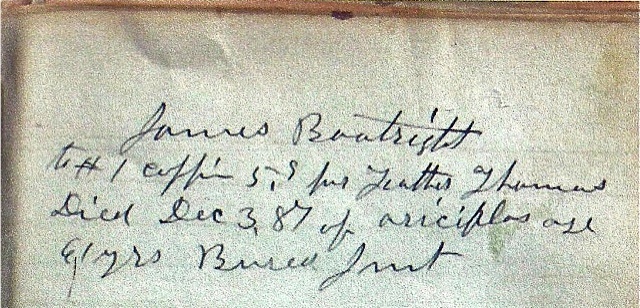
James "John" M. Boatwright bought a coffin for his father, Thomas Boatwright. Thomas died
Dec. 3, 1887, 61 years old. Also noted in this book, a 2 foot coffin was $2.25 and 4 foot
coffin was $3.50. Source: John Albert Undertaking Business, Ironton, Missouri.
1850 Census:
Name: Thomas Boatwright
Date: August 18, 1850
Age: 22
Estimated birth year: abt 1828
Birth place: Tennessee
Gender: Male
Home in 1850
(City,County,State): Kaw, Jackson County, Missouri
Page: 249
Roll: M432_402
1860 Census:
Name: Thomas Boatwright
Date: July 30, 1860
Age in 1860: 33
Birthplace: Tennessee
Home in 1860: Sugarloaf, Marion, Arkansas
Occupation: Farmer
Race: White
Gender: Male
Value of real estate: $0
Post Office: Dubuque
Roll: M653_46
Page: 670
Year: 1860
Head of Household: Thomas Boatwright
1870 Census:
Name: Thomas Boatwright
Date: July 11, 1870
Estimated Birth Year: abt 1830
Age in 1870: 40
Birthplace: Tennessee
Home in 1870: Township 33 Range 3 East, Iron, Missouri
Occupation: Farmer
Race: White
Gender: Male
Value of real estate: $0
Post Office: Ironton
Roll: M593_780
Page: 538
Image: 609
Year: 1870
1880 Census:
Name: Thomas Boatright
Date: June 15, 1880
Age: 52
Birth Year: abt 1828
Birthplace: Tennessee
Home in 1880: Bellevue, Washington, Missouri
Race: White
Gender: Male
Relation to Head of House: Self (Head)
Marital Status: Married
Spouse's Name: Rebecca Bealright
Father's Birthplace: Tennessee
Mother's Birthplace: Tennessee
Occupation: Farmer
Census Place: Bellevue, Washington, Missouri;
Roll: 740; Family History Film: 1254740; Page: 52B;
Enumeration District: 171; Image: 0310.
Death Record for Thomas Boatright
Name: Boatright, Thomas
Age: 61 years
Cause of Death: Erysipelas
Source: John Albert Undertaking Business
Death Date: 3 December 1887
Place of Death: Iron Co.
Cemetery: Iron Mountain, Missouri
Notes: Undertaker/Mortician - John Albert
Father of James BOATRIGHT.
Burial: Iron Mountain Cemetery, Iron County, Missouri
Notes for LUCINDA COKER:
Lucinda was the sister of Mahala Coker, who married Thomas' brother Dock.
In the 1850 Marion County, Arkansas census Lucinda Coker Nepp and her children Henry age
5, Jackson age 4 and Charles age 1 are shown living with Lucinda's parents, Charles and
Elizabeth Coker and family.
In the 1860 Marion County, Arkansas census, Jackson and Charles are listed as "Boatwright".
Lucinda and some of the children are rumored to have died during the Civil War. By 1870,
Thomas had remarried.
In the 1880 Randolph County, Arkansas census, Charles is listed as "Nipps".
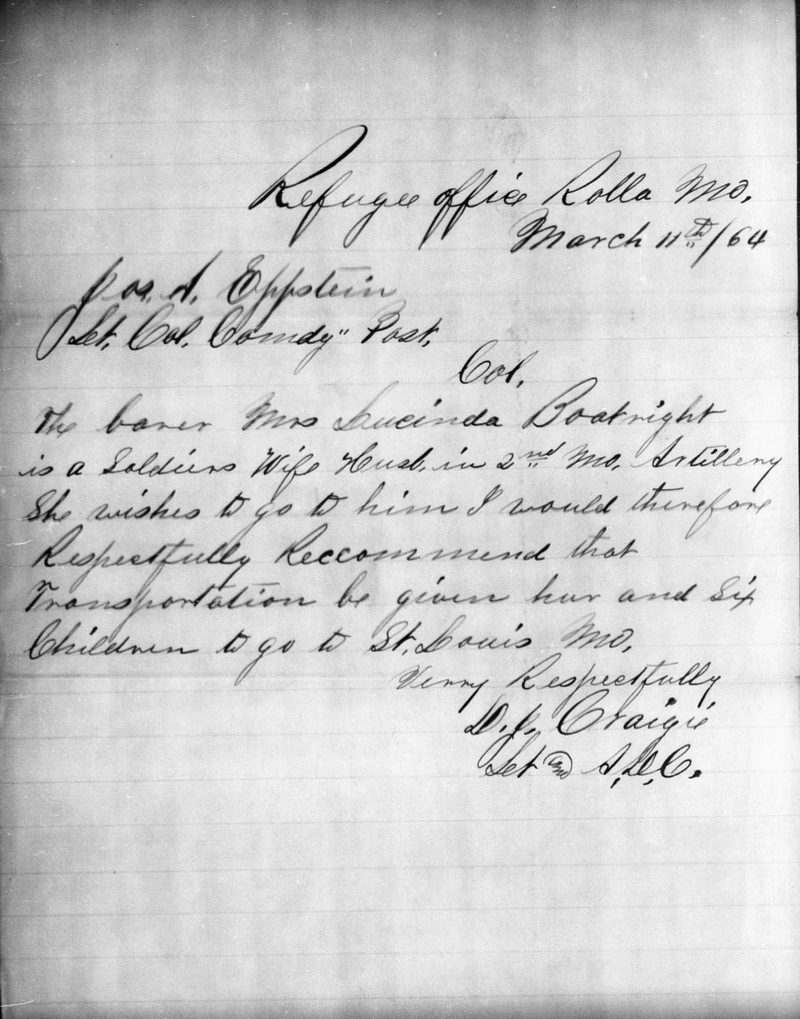
1860 Census:
Name: Lucinda Boatwright
Date: July 30, 1860
Age in 1860: 34
Birthplace: Arkansas
Home in 1860: Sugarloaf, Marion, Arkansas
Race: White
Gender: Female
Value of real estate: $0
Post Office: Dubuque
Roll: M653_46
Page: 670
Year: 1860
Head of Household: Thomas Boatwright
Notes for REBECCA PHILLIPS:
Rebecca remarried in 1891 after the death of Thomas Boatwright in 1887: James M. Gann of
Washington County, Missouri and Rebecca Boatwright of Iron Mountain, Missouri; married on
09 March 1891 by Franz Dinger, J. P.
1870 Census:
Name: Rebecca Boatwright
Date: July 11, 1870
Estimated Birth Year: abt 1835
Age in 1870: 35
Birthplace: Ohio
Home in 1870: Township 33 Range 3 East, Iron, Missouri
Race: White
Gender: Female
Value of real estate: $0
Post Office: Ironton
Roll: M593_780
Page: 538
Image: 609
Year: 1870
1880 Census:
Name: Rebecca Boatright
Date: June 15, 1880
Age: 39
Birth Year: abt 1841
Birthplace: Ohio
Home in 1880: Bellevue, Washington, Missouri
Race: White
Gender: Female
Relation to Head of House: Wife
Marital Status: Married
Spouse's Name: Thomas Bealright
Father's Birthplace: Ohio
Mother's Birthplace: Ohio
Census Place: Bellevue, Washington, Missouri;
Roll: 740; Family History Film: 1254740; Page: 52B;
Enumeration District: 171; Image: 0310.
Missouri Marriage Records, 1805-2002
Name: James M Gann
Marriage Date: 9 Mar 1891
Marriage Location: Ironton, Iron, Missouri
Marriage County: Iron
Spouse Name: Rebecca Boatorght
Children of THOMAS BOATWRIGHT and LUCINDA COKER are:
9-296. i. WILLIAM BOATWRIGHT, b. 1852, Arkansas.
9-297. ii. JOSEPH CALVIN BOATWRIGHT, b. 29 Nov 1854, Marion County, Arkansas;
d. 09 Nov 1923, Shawnee Memorial Hospital,
Shawnee, Pottawatomie County, Oklahoma.
9-298. iii. JAMES "JOHN" M. BOATWRIGHT, b. Mar 1857, Marion County, Arkansas;
d. 04 Jul 1907, Mill Spring, Wayne County,
Missouri.
9-299. iv. LUTICIA KASSIA BOATWRIGHT, b. 1859, Marion County, Arkansas.
Children of THOMAS BOATWRIGHT and REBECCA PHILLIPS are:
9-300. v. MARY ELIZABETH BOATWRIGHT, b. 1867, Iron County, Missouri;
d. Mar 1891, Missouri.
9-301. vi. JOHN T. BOATRIGHT, b. 05 Jul 1868, Iron County, Missouri;
d. 17 Mar 1940, Farmington, St. Francois County,
Missouri.
9-302. vii. WILLIAM HENRY BOATRIGHT, b. 04 Aug 1870, Iron County, Missouri;
d. 19 Feb 1932, Ironton, Iron County, Missouri.
9-303. viii. NANCY E. BOATWRIGHT, b. Jun 1870, Iron County, Missouri;
d. Bef. 1880, Iron County, Missouri.
9-303A. ix. RICHARD BOATWRIGHT, b. Nov 1872, Iron County, Missouri.
9-304. x. EDWARD B. BOATWRIGHT, b. 20 Feb 1875, Iron County, Missouri;
d. 09 May 1943, Madison County, Missouri.
9-304A. xi. MISSOURI A. BOATWRIGHT, b. 1877, Iron County, Missouri.
9-304B. xii. MARTHA C. BOATWRIGHT, b. 1880, Washington County, Missouri.
8-143. DOCK BOATWRIGHT (WILLIAM8, JACOB7, WILLIAM6, THOMAS5, JOHN4, JOHN3, JOHN2, Not Yet Determined1) was born
1830 in Henderson County, Tennessee, and died 1863 in Carroll County, Arkansas. He married (1)
MAHALA COKER, 1849 in Carroll County, Arkansas. She was born 1830 in Carroll County,
Arkansas, and died 1861. He married (2) ELIZABETH GILBERT, 1863 in Batesville,
Independence County, Arkansas. She was born Feb 1847 in Owesley County, Kentucky, and died
in Ozark, Johnson County, Arkansas.
Notes for MAHALA COKER:
Mahala was the sister of Lucinda Coker, who married Dock's brother Thomas.
Notes for ELIZABETH GILBERT:
Burial: Boston Cemetery, Boston Arkansas
8-144. CYNTHIA BOATWRIGHT (WILLIAM8, JACOB7, WILLIAM6, THOMAS5, JOHN4, JOHN3, JOHN2, Not Yet Determined1) was born
1835 in Henderson County, Tennessee.
Notes for CYNTHIA BOATWRIGHT:
1850 Census:
Name: Cyntha Boatwright
Date: August 18, 1850
Age: 15
Estimated birth year: abt 1835
Birth place: Tennessee
Gender: Female
Home in 1850
(City,County,State): Kaw, Jackson County, Missouri
Page: 249
Roll: M432_402
8-145. NANCY BOATWRIGHT (WILLIAM8, JACOB7, WILLIAM6, THOMAS5, JOHN4, JOHN3, JOHN2, Not Yet Determined1) was born
Jul 1836 in Henderson County, Tennessee. She married DANIEL S. PARKER.
Notes for NANCY BOATWRIGHT:
1850 Census:
Name: Nancy Boatwright
Date: August 18, 1850
Age: 14
Estimated birth year: abt 1836
Birth place: Tennessee
Gender: Female
Home in 1850
(City,County,State): Kaw, Jackson County, Missouri
Page: 249
Roll: M432_402
8-146. RICHARD BOATWRIGHT (WILLIAM8, JACOB7, WILLIAM6, THOMAS5, JOHN4, JOHN3, JOHN2, Not Yet Determined1) was born
1840 in Henderson County, Tennessee, and died Bef 1870 in Missouri. He married
NANCY SAFINA OWEN, daughter of JESSE OWEN and NANCY JONES. She was born
1846 in Johnson County, Tennessee, and died 23 Oct 1926 in St. Louis County, Missouri.
Notes for RICHARD BOATWRIGHT:
1850 Census:
Name: Richard Boatwright
Date: August 18, 1850
Age: 12
Estimated birth year: abt 1838
Birth place: Tennessee
Gender: Male
Home in 1850
(City,County,State): Kaw, Jackson County, Missouri
Page: 249
Roll: M432_402
1860 Census:
Name: Richard Boatright
Date: September 24, 1860
Age in 1860: 20
Birthplace: Tennessee
Home in 1860: Sugar Loaf, Carroll County, Arkansas
Gender: Male
Value of real estate: $0
Post Office: Dubuque
Roll: M653_38
Page: 914
Year: 1860
Head of Household: William Boatright
Notes for NANCY SAFINA OWEN:
1850 Census:
Name: Nancy S Owens
Date: October 2, 1850
Age: 4
Estimated birth year: abt 1846
Birth Place: Tennessee
Gender: Female
Home in 1850 (City,County,State): District 6, Johnson, Tennessee
Family Number: 14
Census Place: District 6, Johnson, Tennessee;
Roll M432_886; Page: 35A; Image: 74.
1860 Census:
Name: Nancy S Owen
Date: June 18, 1860
Age in 1860: 14
Birth Year: abt 1846
Birthplace: Tennessee
Home in 1860: Howell, Howell, Missouri
Gender: Female
Post Office: West Plains
Census Place: Howell, Howell, Missouri;
Roll M653_624; Page: 560; Image: 20;
Family History Library Film: 803624.
1870 Census:
Name: Nancy Boatright
Date: July 1, 1870
Birth Year: abt 1846
Age in 1870: 24
Birthplace: Tennessee
Home in 1870: Rolla, Phelps, Missouri
Race: White
Gender: Female
Post Office: Rolla
Census Place: Rolla, Phelps, Missouri;
Roll M593_797; Page: 693B; Image: 610;
Family History Library Film: 552296.
living with parents
Missouri Marriage Records, 1805-2002
Name: Nancy S Boatright
Marriage Date: 17 Dec 1876
Marriage County: Phelps
Spouse Name: G B Newton
1880 Census:
Name: Nancy Newton
Date: June 5, 1880
Home in 1880: Dillon, Phelps, Missouri
Age: 33
Estimated birth year: abt 1847
Birthplace: Tennessee
Relation to Head of Household: Self (Head)
Father's birthplace: North Carolina
Mother's birthplace: Tennessee
Occupation: Keeping House
Marital Status: Widowed
Race: White
Gender: Female
Census Place: Dillon, Phelps, Missouri;
Roll T9_709; Family History Film: 1254709; Page: 335.3000;
Enumeration District: 124; Image: 0040.
1900 Census:
Name: Nancy S Boatwright
Date: June 2, 1900
Home in 1900: Rolla, Phelps, Missouri
Age: 54
Birth Date: Jul 1845
Birthplace: Tennessee
Race: White
Gender: Female
Relationship to Head of House: Sister
Father's Birthplace: North Carolina
Mother's Birthplace: Tennessee
Mother: number of living children: 1
Mother: How many children: 1
Marital Status: Widowed
Residence : Rolla City, Phelps, Missouri
Census Place: Rolla, Phelps, Missouri;
Roll T623_881; Page: 3A;
Enumeration District: 108.
Living with her sister Mary
Missouri Marriage Records, 1805-2002
Name: Mrs. Nancy S Newton
Age: 55
Birth Date: abt 1847
Marriage Date: 16 Aug 1902
Marriage Location: Phelps, Missouri
Marriage County: Phelps
Spouse Name: Mr. Isael P Morse
Spouse Age: 66
1910 Census:
Name: Nancy S Morse
Date: April 28, 1910
Age in 1910: 64
Estimated birth year: abt 1846
Birthplace: Tennessee
Relation to Head of House: Wife
Father's Birth Place: North Carolina
Mother's Birth Place: Tennessee
Spouse's name: J P
Home in 1910: Rolla Ward 2, Phelps, Missouri
Marital Status: Married
Race: White
Gender: Female
Census Place: Rolla Ward 2, Phelps, Missouri;
Roll T624_797; Page: 21B;
Enumeration District: 69; Image: 1061.
1920 Census:
Name: Nancy S Morse
Date: January 3, 1920
Home in 1920: Maryland Heights, St Louis, Missouri
Age: 73 years
Estimated birth year: abt 1847
Birthplace: Tennessee
Relation to Head of House: Mother
Father's Birth Place: North Carolina
Mother's Birth Place: North Carolina
Marital Status: Widow
Race: White
Sex: Female
Able to read: Yes
Able to Write: Yes
Census Place: Maryland Heights, St Louis, Missouri;
Roll T625_946; Page: 1B;
Enumeration District: 132; Image: 776.
Burial: Rolla Cemetery, Rolla, Phelps County, Missouri
Child of RICHARD BOATWRIGHT and NANCY OWEN is:
9-304C. i. JOHN P. BOATWRIGHT, b. 24 April 1866, Missouri; d. 16 Feb 1954,
St. Louis County, Missouri.
8-147. MARTHA ADELINE BOATWRIGHT (WILLIAM8, JACOB7, WILLIAM6, THOMAS5, JOHN4, JOHN3, JOHN2, Not Yet Determined1) was born
1842 in Henderson County, Tennessee.
Notes for MARTHA ADELINE BOATWRIGHT:
1850 Census:
Name: Adeline Boatwright
Date: August 18, 1850
Age: 14
Estimated birth year: abt 1836
Birth place: Tennessee
Gender: Female
Home in 1850
(City,County,State): Kaw, Jackson County, Missouri
Page: 249
Roll: M432_402
1860 Census:
Name: Matha A Boatright
Date: September 24, 1860
Age in 1860: 18
Birthplace: Tennessee
Home in 1860: Sugar Loaf, Carroll County, Arkansas
Gender: Female
Value of real estate: $0
Post Office: Dubuque
Roll: M653_38
Page: 914
Year: 1860
Head of Household: William Boatright
8-148. JOHN LEWIS BOATWRIGHT (WILLIAM8, JACOB7, WILLIAM6, THOMAS5, JOHN4, JOHN3, JOHN2, Not Yet Determined1) was born
1844 in Henderson County, Tennessee, and died 15 May 1888 in Mansfield, Wright
County, Missouri.
Notes for JOHN LEWIS BOATWRIGHT:
1850 Census:
Name: Louis Boatwright
Date: August 18, 1850
Age: 6
Estimated birth year: abt 1844
Birth place: Tennessee
Gender: Male
Home in 1850
(City,County,State): Kaw, Jackson County, Missouri
Page: 249
Roll: M432_402
1860 Census:
Name: John L Boatright
Date: September 24, 1860
Age in 1860: 16
Birthplace: Tennessee
Home in 1860: Sugar Loaf, Carroll County, Arkansas
Gender: Male
Value of real estate: $0
Post Office: Dubuque
Roll: M653_38
Page: 914
Year: 1860
Head of Household: William Boatright
8-149. JULIANN BOATWRIGHT (WILLIAM8, JACOB7, WILLIAM6, THOMAS5, JOHN4, JOHN3, JOHN2, Not Yet Determined1) was born
1846 in Arkansas.
Notes for JULIANN BOATWRIGHT:
1850 Census:
Name: Julia Boatwright
Date: August 18, 1850
Age: 4
Estimated birth year: abt 1846
Birth place: Arkansas
Gender: Female
Home in 1850
(City,County,State): Kaw, Jackson County, Missouri
Page: 249
Roll: M432_402
1860 Census:
Name: Juliann Boatright
Date: September 24, 1860
Age in 1860: 15
Birthplace: Arkansas
Home in 1860: Sugar Loaf, Carroll County, Arkansas
Gender: Female
Value of real estate: $0
Post Office: Dubuque
Roll: M653_38
Page: 914
Year: 1860
Head of Household: William Boatright
8-150. PRUDENCE CATHERINE BOATWRIGHT (WILLIAM8, JACOB7, WILLIAM6, THOMAS5, JOHN4, JOHN3, JOHN2, Not Yet Determined1) was born
1848 in Arkansas.
Notes for PRUDENCE CATHERINE BOATWRIGHT:
1850 Census:
Name: Catherine Boatwright
Date: August 18, 1850
Age: 3
Estimated birth year: abt 1847
Birth place: Arkansas
Gender: Female
Home in 1850
(City,County,State): Kaw, Jackson County, Missouri
Page: 249
Roll: M432_402
1860 Census:
Name: Prudence C Boatright
Date: September 24, 1860
Age in 1860: 12
Birthplace: Arkansas
Home in 1860: Sugar Loaf, Carroll County, Arkansas
Gender: Female
Value of real estate: $0
Post Office: Dubuque
Roll: M653_38
Page: 914
Year: 1860
Head of Household: William Boatright
8-151. PETER B. BOATRIGHT (WILLIAM8, JACOB7, WILLIAM6, THOMAS5, JOHN4, JOHN3, JOHN2, Not Yet Determined1) was born
02 Sep 1851 in Arkansas, and died 06 Apr 1917 in Ozark County, Missouri. He married
FRANCES LEVINA MIDGETT 23 Mar 1873 in Ozark County, Missouri, daughter of
MICAJAH MIDGETT and SUSAN MILLER. She was born 23 May 1852 in
Calloway County, Kentucky, and died 25 Sep 1935 in Bridges, Ozark County, Missouri.
Notes for PETER B. BOATRIGHT:
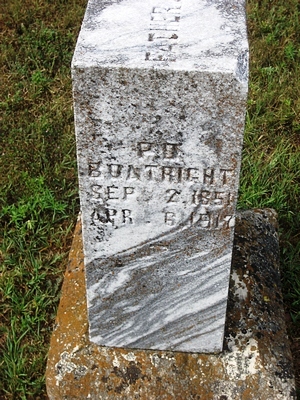
1860 Census:
Name: Peter Boatright
Date: September 24, 1860
Age in 1860: 9
Birthplace: Missouri
Home in 1860: Sugar Loaf, Carroll County, AR
Gender: Male
Value of real estate: $0
Post Office: Dubuque
Roll: M653_38
Page: 914
Year: 1860
Head of Household: William Boatright
1880 Census:
Name: Peter BOATWRIGHT
Date: June 10, 1880
Age: 28
Estimated birth year: <1852>
Birthplace: Arkansas
Occupation: Farmer
Relationship to head-of-household: Self
Home in 1880: Bayou, Ozark, Missouri
Marital status: Married
Race: White
Gender: Male
Spouse's name: Francis BOATWRIGHT
Father's birthplace: ---
Mother's birthplace: TN
Census Place: Bayou, Ozark, Missouri;
Roll: T9_707; Family History Film: 1254707; Page: 554D;
Enumeration District: 110; Image: 0695.
1900 Census:
Name: Peter B Boatwright
Date: June 16, 1900
Home in 1900: Bayou, Ozark, Missouri
Age: 48
Estimated birth year: 1852
Birthplace: Missouri
Race: White
Relationship to head-of-house: Head
Occupation: Farmer
Census Place: Bayou, Ozark, Missouri;
Roll: T623 880; Page: 6A;
Enumeration District: 91.
1910 Census:
Name: Peter B Boatright
Date: April 18, 1910
Age in 1910: 58
Estimated birth year: abt 1852
Birthplace: Missouri
Home in 1910: Bridges, Ozark, Missouri
Occupation: Farmer
Race: White
Gender: Male
Marital Status: Married
Relation to Head of House: Head
Mother's Birth Place: Tennessee
Father's Birth Place: Tennessee
Census Place: Bridges, Ozark, Missouri;
Roll: T624_804; Page: 4A;
Enumeration District: 134; Image: 437.
Burial: Sallee Cemetery, Ozark County, Missouri
Notes for FRANCES LEVINA MIDGETT:
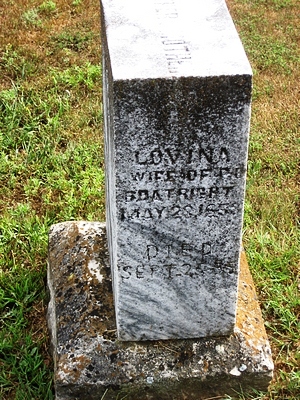
Kentucky Birth Records, 1852-1910
Name: Frances L Midgett
Birth Date: 23 May 1852
Birth County: Calloway
Ethnicity: White
Gender: Female
Father's Name: M Midgett
Mother's Name: Susan Miller
County of Residence: Calloway
1880 Census:
Name: Francis BOATWRIGHT
Date: June 10, 1880
Age: 28
Estimated birth year: <1852>
Birthplace: Kentucky
Occupation: Keeping House
Relationship to head-of-household: Wife
Home in 1880: Bayou, Ozark, Missouri
Marital status: Married
Race: White
Gender: Female
Spouse's name: Peter BOATWRIGHT
Father's birthplace: KY
Mother's birthplace: IN
Census Place: Bayou, Ozark, Missouri;
Roll: T9_707; Family History Film: 1254707; Page: 554D;
Enumeration District: 110; Image: 0695.
1900 Census:
Name: Frances Boatwright
Date: June 16, 1900
Home in 1900: Bayou, Ozark, Missouri
Age: 48
Estimated birth year: 1852
Birthplace: Kentucky
Race: White
Relationship to head-of-house: Wife
Census Place: Bayou, Ozark, Missouri;
Roll: T623 880; Page: 6A;
Enumeration District: 91.
1910 Census:
Name: Frances L Boatright
Date: April 18, 1910
Age in 1910: 58
Estimated birth year: abt 1852
Birthplace: Missouri
Home in 1910: Bridges, Ozark, Missouri
Occupation: Farmer
Race: White
Gender: Male
Marital Status: Married
Relation to Head of House: Head
Mother's Birth Place: Tennessee
Father's Birth Place: Tennessee
Census Place: Bridges, Ozark, Missouri;
Roll: T624_804; Page: 4A;
Enumeration District: 134; Image: 437.
1920 Census:
Name: Vina Boatright
Date: January 21, 1920
Age: 67 years
Estimated birth year: abt 1853
Birthplace: Kentucky
Race: White
Home in 1920: Bridges, Ozark, Missouri
Sex: Female
Marital status: Widow
Relation to Head of House: Mother
Mother's Birth Place: South Carolina
Father's Birth Place: South Carolina
Census Place: Bridges, Ozark, Missouri;
Roll: T625_936; Page: 10A;
Enumeration District: 148; Image: 1003.
Burial: Sallee Cemetery, Ozark County, Missouri
Children of PETER BOATRIGHT and FRANCES MIDGETT are:
9-305. i. WILLIAM D. BOATRIGHT, b. 22 Nov 1874, Ozark County, Missouri.
9-306. ii. MICAJAH RICHARD BOATRIGHT, b. 11 Mar 1876, Ozark County, Missouri;
d. 07 Oct 1941, Ozark County,
Missouri.
9-307. iii. JOHN LEONARD BOATRIGHT, b. 01 May 1877, Ozark County, Missouri;
d. 28 Dec 1967, Republic, Greene County,
Missouri.
9-308. iv. LUCY BELL BOATRIGHT, b. 24 Feb 1881, Ozark County, Missouri;
d. 07 Jun 1953, West Plains, Howell County,
Missouri.
9-309. v. OSCAR OLIVER BOATRIGHT, b. 15 Aug 1883, Ozark County, Missouri;
d. 12 Aug 1958, Springfield, Greene
County, Missouri.
9-310. vi. JAMES AUSTIN BOATRIGHT, b. 22 Jul 1886, Ozark County, Missouri;
d. 25 Jan 1938, Greene County, Missouri.
9-311. vii. ROSCOE COCKLIN "BOSS" BOATRIGHT, b. 22 Jul 1889, Ozark County, Missouri;
d. 17 Apr 1986, Springfield,
Greene County, Missouri.
8-152. WILLIAM M. BOATWRIGHT (WILLIAM8, JACOB7, WILLIAM6, THOMAS5, JOHN4, JOHN3, JOHN2, Not Yet Determined1) was born
1856 in Arkansas.
Notes for WILLIAM M. BOATWRIGHT:
1860 Census:
Name: William M Boatright
Date: September 24, 1860
Age in 1860: 3
Birthplace: Arkansas
Home in 1860: Sugar Loaf, Carroll County, Arkansas
Gender: Male
Value of real estate: $0
Post Office: Dubuque
Roll: M653_38
Page: 914
Year: 1860
Head of Household: William Boatright
Boatwright/Boatright Family Genealogy Website
created by George Boatright, boatgenealogy@yahoo.com
Please e-mail any additions / corrections / comments.
last modified: May 21, 2013
URL: http://www.boatwrightgenealogy.com
Navigation /
Home /
Index /
Documents /
Photos /
Stories /
Gravestones /
Obits /
Generation 7 /
Generation 9
 The Florence Prison Stockade was in operation for approximately 5 months during the time
period of Sept 1864 through Feb 1865. During this time, as many as 15 - 18,000 Union
soldiers were held captive. Of these, approximately 2,802 Union soldiers died; most of
whom are buried as unknowns in the Florence National Cemetery.
The Florence Prison Stockade was in operation for approximately 5 months during the time
period of Sept 1864 through Feb 1865. During this time, as many as 15 - 18,000 Union
soldiers were held captive. Of these, approximately 2,802 Union soldiers died; most of
whom are buried as unknowns in the Florence National Cemetery.
 Most of the prisoners that were sent to Savannah would eventually find themselves back at
Andersonville after being held captive in various prisons in Georgia. Although, some of
these did end up at Florence. Those that arrived in Charleston were mainly held at the
Charleston Race Course, which today is known as Hampton Park. Some were also held in the
jailyard of the Charleston City Jail and the Workhouse. All of these were holding areas
for the prisoners until the building of the stockade at Florence could be completed.
Most, if not all, of the Enlisted prisoners at Charleston were sent to Florence.
Most of the prisoners that were sent to Savannah would eventually find themselves back at
Andersonville after being held captive in various prisons in Georgia. Although, some of
these did end up at Florence. Those that arrived in Charleston were mainly held at the
Charleston Race Course, which today is known as Hampton Park. Some were also held in the
jailyard of the Charleston City Jail and the Workhouse. All of these were holding areas
for the prisoners until the building of the stockade at Florence could be completed.
Most, if not all, of the Enlisted prisoners at Charleston were sent to Florence.

 Capt. Wirz was later hung for war crimes related to Andersonville, but Lt. Barrett
escaped this same fate by fleeing to Germany where he married and remained many years.
He would die later of natural causes in 1910 at Augusta, Georgia.
Capt. Wirz was later hung for war crimes related to Andersonville, but Lt. Barrett
escaped this same fate by fleeing to Germany where he married and remained many years.
He would die later of natural causes in 1910 at Augusta, Georgia.
 One of the five "known" interments in the trenches is that of Florena Budwin who disguised
herself as a man and enlisted in the Union Army in order to follow her husband, a Captain
from Pennsylvania. Her husband was killed and Florena was captured. Her identity was
finally discovered in the prison stockade at Florence, where she remained to help nurse
the prisoners until she became ill and died on January 25, 1865. She is believed to be
the first female service member to be buried in a National Cemetery. (She has the only
marked grave in Row # 13)
One of the five "known" interments in the trenches is that of Florena Budwin who disguised
herself as a man and enlisted in the Union Army in order to follow her husband, a Captain
from Pennsylvania. Her husband was killed and Florena was captured. Her identity was
finally discovered in the prison stockade at Florence, where she remained to help nurse
the prisoners until she became ill and died on January 25, 1865. She is believed to be
the first female service member to be buried in a National Cemetery. (She has the only
marked grave in Row # 13)
 1850 Census:
Name: Samuel Boatright
Date: November 29, 1850
Age: 17
Estimated birth year: abt 1833
Birth place: Tennessee
Gender: Male
Home in 1850
(City,County,State): District 16,
Henderson County, Tennessee
Page: 224
Roll: M432_883
1860 Census:
Name: S Boatwright
Date: September 18, 1860
Age in 1860: 27
Birthplace: Tennessee
Home in 1860: District 20, Henderson, Tennessee
Occupation: Farmer
Gender: Male
Value of real estate: $0
Post Office: Lexington
Roll: M653_1256
Page: 327
Year: 1860
Head of Household: S Boatwright
Civil War Service Records
Name: Samuel Boatwright
Company: A
Unit: 7 Tennessee Cavalry.
Rank - Induction: Private
Rank - Discharge: Farrier
Allegiance: Union
Served with brother Ananias
Code No:69574
Grave No: 0
Last Name: Boatright
First Name: Samuel
Rank: Private
Company: A
Regiment: 7
State: TN
Branch Of Service : Cavalry
Date of Death: 10/23/1864
Remarks* Died in prison at Florence, South Carolina, October 23, 1864
Reference: TN ADG RPT: 478
Place Captured: TN ADG RPT: 478
Date Captured: 3/24/1864
1850 Census:
Name: Samuel Boatright
Date: November 29, 1850
Age: 17
Estimated birth year: abt 1833
Birth place: Tennessee
Gender: Male
Home in 1850
(City,County,State): District 16,
Henderson County, Tennessee
Page: 224
Roll: M432_883
1860 Census:
Name: S Boatwright
Date: September 18, 1860
Age in 1860: 27
Birthplace: Tennessee
Home in 1860: District 20, Henderson, Tennessee
Occupation: Farmer
Gender: Male
Value of real estate: $0
Post Office: Lexington
Roll: M653_1256
Page: 327
Year: 1860
Head of Household: S Boatwright
Civil War Service Records
Name: Samuel Boatwright
Company: A
Unit: 7 Tennessee Cavalry.
Rank - Induction: Private
Rank - Discharge: Farrier
Allegiance: Union
Served with brother Ananias
Code No:69574
Grave No: 0
Last Name: Boatright
First Name: Samuel
Rank: Private
Company: A
Regiment: 7
State: TN
Branch Of Service : Cavalry
Date of Death: 10/23/1864
Remarks* Died in prison at Florence, South Carolina, October 23, 1864
Reference: TN ADG RPT: 478
Place Captured: TN ADG RPT: 478
Date Captured: 3/24/1864








 There was a fellow prisoner named Dorence Atwater who was a close friend of the first one
who died (Adam Swarner) and he volunteered to keep the records. He wanted to make sure
that those who died here were remembered and so the families would know the fate and
burial place of their loved ones. When the dead were brought out of the stockade to
the "Deadhouse" they were brought by friends who knew them. They would report what was
known about the dead man such as name, State, Regiment, date of death, cause, etc.
Atwater recorded them numerically and attached a tag to the body which matched the number
in the records. The dead then were taken to the cemetery where the first dozen were
buried in pine boxes, however since the numbers dying each day was growing so fast, and
limited resources, the dead were stripped naked so the living could use what the dead no
longer needed. The bodies were then laid in trench type graves dug 4 feet deep and long
enough for 150 to 200 bodies and shoulder to shoulder without coffins.
There was a fellow prisoner named Dorence Atwater who was a close friend of the first one
who died (Adam Swarner) and he volunteered to keep the records. He wanted to make sure
that those who died here were remembered and so the families would know the fate and
burial place of their loved ones. When the dead were brought out of the stockade to
the "Deadhouse" they were brought by friends who knew them. They would report what was
known about the dead man such as name, State, Regiment, date of death, cause, etc.
Atwater recorded them numerically and attached a tag to the body which matched the number
in the records. The dead then were taken to the cemetery where the first dozen were
buried in pine boxes, however since the numbers dying each day was growing so fast, and
limited resources, the dead were stripped naked so the living could use what the dead no
longer needed. The bodies were then laid in trench type graves dug 4 feet deep and long
enough for 150 to 200 bodies and shoulder to shoulder without coffins.
 Notes for WILLIAM GREENE BOATRIGHT:
Notes for WILLIAM GREENE BOATRIGHT:
 William Greene Boatright was the son of Jacob and Judith Boatright, and was born in Boone
County, Missouri in January 24, 1830. Jacob and Judith, shortly afterwards, moved to Howard
County, then into Saline County, arriving in 1842. They located on a bottom farm north of
Arrow Rock and continued to live in this vicinity until the high waters of 1844 forced them to
seek higher ground. They next located on a farm about six miles northwest of Marshall, in
section 15, township 51, range 21, now known as the "Spicer Farm". There Jacob and Judith
reared their family of eight children. Jacob and Judith died of pneumonia at this home place.
They are buried in the Mt. Carmel Cemetery, north of Marshall.
William Greene Boatright was the son of Jacob and Judith Boatright, and was born in Boone
County, Missouri in January 24, 1830. Jacob and Judith, shortly afterwards, moved to Howard
County, then into Saline County, arriving in 1842. They located on a bottom farm north of
Arrow Rock and continued to live in this vicinity until the high waters of 1844 forced them to
seek higher ground. They next located on a farm about six miles northwest of Marshall, in
section 15, township 51, range 21, now known as the "Spicer Farm". There Jacob and Judith
reared their family of eight children. Jacob and Judith died of pneumonia at this home place.
They are buried in the Mt. Carmel Cemetery, north of Marshall.
 William Greene Boatright purchased a farm northwest of Herndon in section 23, township 49,
range 22, now known as the "Schrader Farm". Shortly after taking possession of this farm,
William went to an old-fashioned revival meeting, which in those days was held in a shady
grove, and while at this meeting Nancy Buie rode up on her horse. William made the remark
to someone by who he was standing that "there was a gal he was sure going to get acquainted
with before he went home". After the services were over William had his horse and had
untied Nancy's horse and was waiting to assist her to mount. It could have been because
William always wore a smile or it might have been because of Nancy's red hair, but this
proved to be love at first sight and they were married on October 22, 1857, at the home of Mrs.
Nancy Buie and the Rev. James Martin.
William Greene Boatright purchased a farm northwest of Herndon in section 23, township 49,
range 22, now known as the "Schrader Farm". Shortly after taking possession of this farm,
William went to an old-fashioned revival meeting, which in those days was held in a shady
grove, and while at this meeting Nancy Buie rode up on her horse. William made the remark
to someone by who he was standing that "there was a gal he was sure going to get acquainted
with before he went home". After the services were over William had his horse and had
untied Nancy's horse and was waiting to assist her to mount. It could have been because
William always wore a smile or it might have been because of Nancy's red hair, but this
proved to be love at first sight and they were married on October 22, 1857, at the home of Mrs.
Nancy Buie and the Rev. James Martin.


 Notes for NANCY FRANCES "FANNIE" BUIE:
Notes for NANCY FRANCES "FANNIE" BUIE:
 "I often think of the work it required to produce some of the food which was essential in
feeding our family (11 children). To have a barrel of sorghum each fall meant that we had to
grow some cane. This meant hoeing, thinning, plowing, stripping the blades from the stalks
and finally cutting the cane stalks and hauling them to a mill where the juice was pressed from
the stalks and then cooked into sorghum molasses. And in addition to all this work, the man
who cooked the sorghum retained one-half of what he made for his work.
"I often think of the work it required to produce some of the food which was essential in
feeding our family (11 children). To have a barrel of sorghum each fall meant that we had to
grow some cane. This meant hoeing, thinning, plowing, stripping the blades from the stalks
and finally cutting the cane stalks and hauling them to a mill where the juice was pressed from
the stalks and then cooked into sorghum molasses. And in addition to all this work, the man
who cooked the sorghum retained one-half of what he made for his work.






